Juniper Systems MS2 Rugged Tablet User Manual FCC Part 15
Juniper Systems, Inc. Rugged Tablet FCC Part 15
Manual

3998 FAU Blvd. Suite 310 Boca Raton, FL 33431 Tel: 561-961-5585 Fax: 561-961-5587
Certification Exhibit
FCC ID: VSFMS2
IC: 7980A-MS2
FCC Rule Part: 15.247, 15.407
IC Radio Standards Specification: RSS-247
ACS Project: 15-2133
Manufacturer: Juniper Systems, Inc.
Model(s): MS2G, MS2GC
User Manual
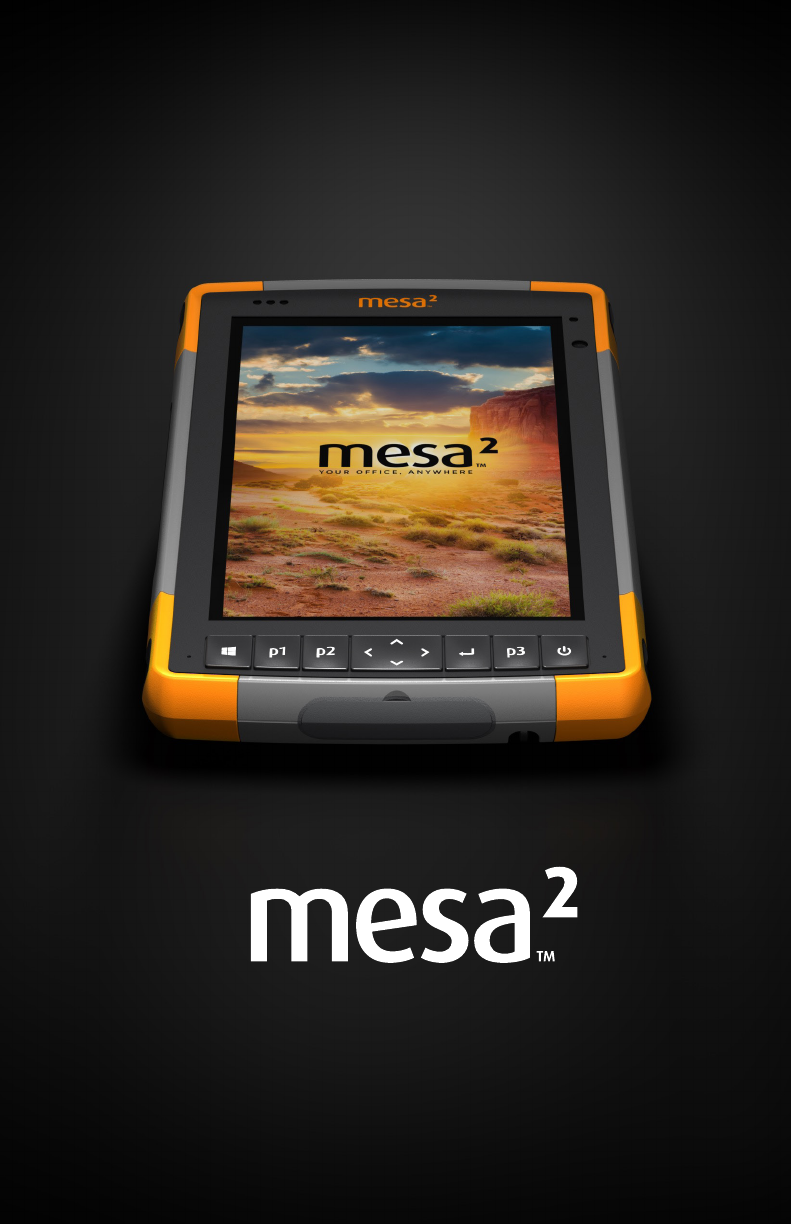
owner’s manual
owner’s manual
OWNER’S MANUAL
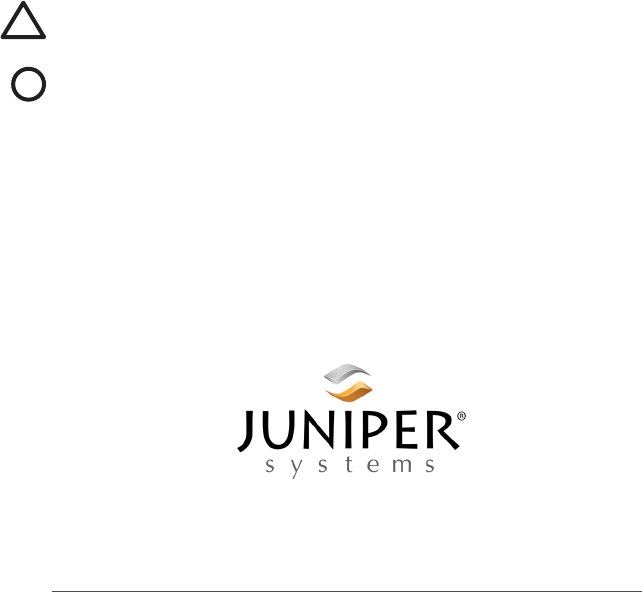
ii Mesa 2 Rugged Tablet Owner’s Manual
tel: 435.753.1881 l web: www.junipersys.com
1132 W. 1700 N. Logan, UT 84321
© Copyright March 2016 Juniper Systems, Inc. All rights
reserved. Information is subject to change without notice.
Juniper Systems® is a registered trademark of Juniper
Systems, Inc. Mesa 2™ is a recognized trademark of Juniper
Systems, Inc.
Windows, Windows 10, Windows 8.1, and the Windows
logo are trademarks or registered trademarks of Microsoft
Corporation in the United States and/or other countries.
The Bluetooth® word mark is owned by the Bluetooth SIG,
Inc. Any use of such marks by Juniper Systems, Inc. is under
license.
Adobe® Acrobat® and Adobe® Reader® are registered
trademarks of Adobe Systems Incorporated in the United
States and/or other countries.
The names of other companies and products mentioned
herein may be the trademarks of their respective owners.
WARNING! This symbol indicates that failure to follow
directions could result in serious injury.
CAUTION: This symbol indicates that failure to follow
directions could result in damage to equipment or loss of
information.
Part Number 25562-00
!
!

Contents iii
Contents
1 Getting Started 1
Perform Initial Tasks 3
Operating System Languages and Document
Updates 8
2 Standard Features 9
Windows 10 Pro Operating System 10
Display and Touchscreen 10
Keypad Features 12
Power Management 13
LED Activity Indicators 16
Light Sensor 16
Connector Ports 18
Audio Features 18
Sleep, Reset, Hibernate, Power-Off, and Recovery 19
Sensors 21
Bluetooth® Wireless Communication 21
Wi-Fi Wireless Networking 22
3 Optional Features 23
GPS/GNSS 24
Camera 25
4G LTE Data Modem 25
Wireless Safety 27
Barcode Scanner 28
RFID Reader 30
A Storage, Maintenance, and Recycling 31
Storing the Mesa 2 and Battery Pack 32
Protecting the Touchscreen 33
Recycling the Mesa 2 and Batteries 33
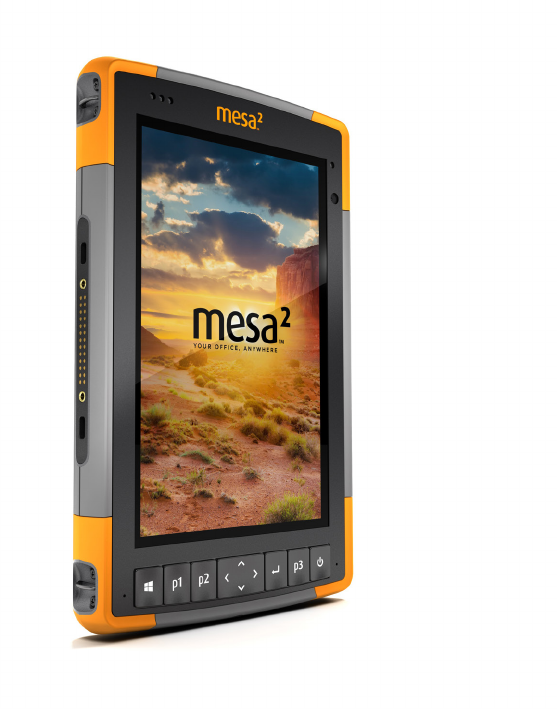
1
Getting
Started
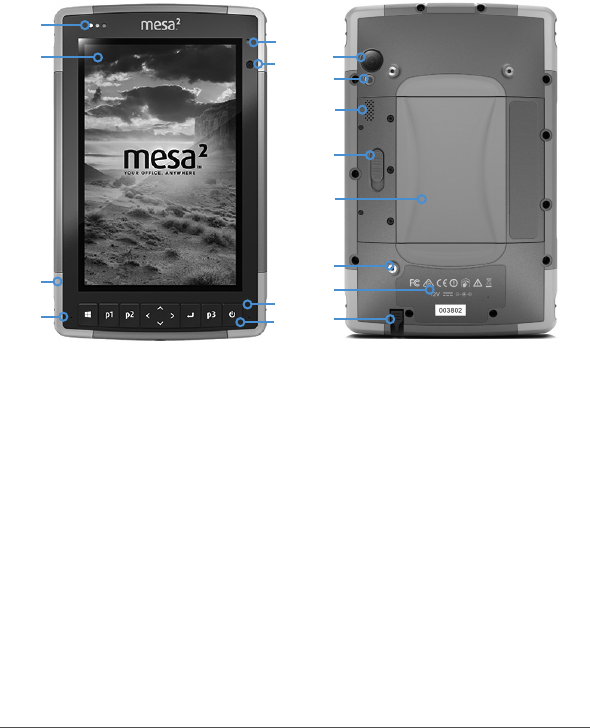
2 Mesa 2 Rugged Tablet Owner’s Manual
Getting Started
The standard features for the Mesa 2 Rugged Tablet™
from Juniper Systems include a 7” display, capacitive
touchscreen, keypad, Bluetooth, and Wi-Fi. Standard
accessories include a lithium-ion battery pack, AC wall
charger, hand strap, connector port cover, and a ne tip
capacitive stylus and tether. Options include front and rear
cameras, GPS/GNSS, a cellular data modem, a barcode
scanner, and a RFID reader.
The Anatomy of the Mesa 2
Front and Back Features
1 Notication LEDs
2 Touchscreen and Display
3 Protective Over-molded Bumper
(all four edges)
4 Microphone (one on each side)
5 Ambient Light Sensor
6 Front Facing Camera Lens, 2 MP
7 Keypad
8 Power Key
9 Rear Facing Camera Lens, 8 MP
10 Camera Flash
11 Speaker
12 Battery Door Lock
13 Door to Removable Battery
Compartment and Card Slots
14 External Device Attachment
Point (1 of 3 on the back)
15 Location of Internal Battery
(not user accessible)
16 Stylus Storage Slot
1
2
3
4
5
6
7
8
9
10
11
12
13
14
15
16
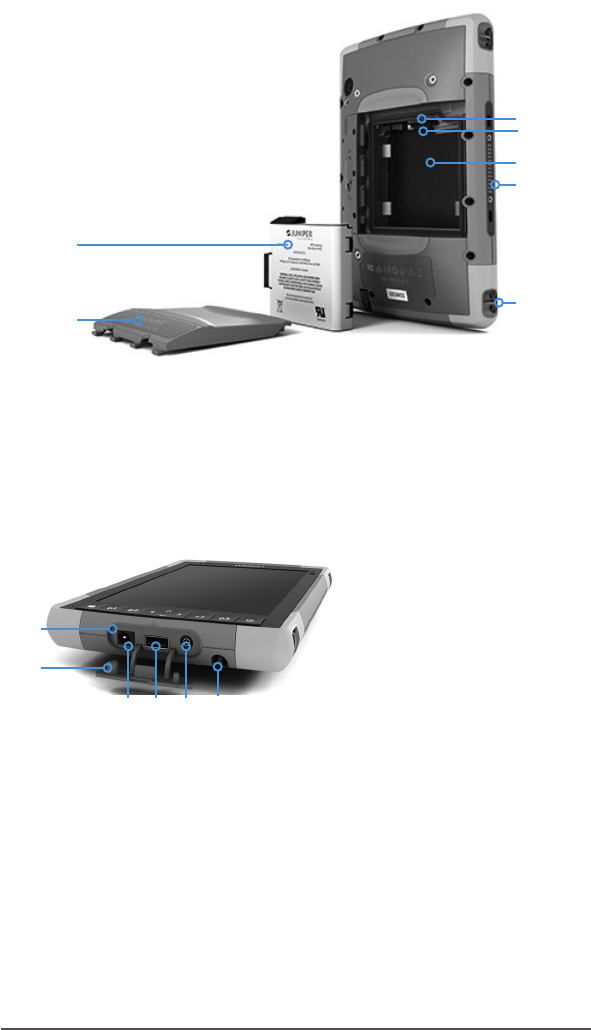
Chapter 1 Getting Started 3
Battery Compartment and Card Slots
Connector Ports
Note: Your Mesa 2 might look different than these images,
Perform Initial Tasks
When you receive your Mesa 2, perform the tasks outlined in
this section before rst use.
Review Documentation
The owner’s manual, quick start guide, and Microsoft®
License Agreement are available in multiple languages.
Other documents like release notes are available in
1 Battery Pack, Removable
2 Battery Door
3 Micro SIM Card Slot and
Micro SD/SDHC Card Slot
(underneath card retainer)
4 Flexible Card Retainer
5 Battery Compartment
6 Docking Connection
7 Hand Strap Attachment
Point (2 on each side)
2
1
5
4
3
6
7
1 Connector Ports
2 Connector Port Protector
3 12 V DC Power Input Jack
4 USB 3.0 Host, Full Size
5 Microphone/Speaker Jack
6 Stylus and Storage Slot
1
3 4 5
2
6
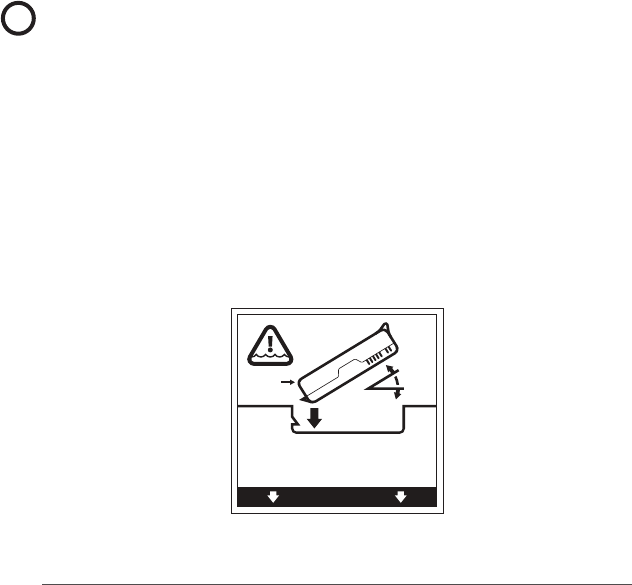
4 Mesa 2 Rugged Tablet Owner’s Manual
English. These documents are located on our website at:
www.junipersys.com/Juniper-Systems-Rugged-Handheld-
Computers/products/Mesa-2/Support. View, download,
and print documents as desired. (Adobe Reader must be
installed on your computer. It is available from Adobe’s
website at: www.adobe.com.)
Documentation will be updated during the life of the Mesa
2. Compare version numbers to see if a document has
changed.
Install the Battery Pack, Micro SD Card, and Micro SIM
Card
The Mesa 2 comes with a rechargeable and removable
Li-Ion battery pack. Install and charge the battery pack as
follows:
1. The battery compartment is accessed from the back of
the tablet. Push the battery lock switch in, slide it to the
unlocked position, and remove the door.
CAUTION: The Mesa 2 is not sealed against water and
dust when the battery door is not installed.
2. If you are using a micro SD card for additional memory
or a micro SIM card with the Cellular Data Modem
(optional), you can install them now before you install
the battery pack or at another time. If you do this,
make sure you replace the exible card retainer before
installation of the battery. See Chapter 2, Standard
Features, SD Cards for more details.
3. Follow the graphic on the battery label to insert the
battery pack properly.
TO ENSURE DOOR SEAL, INSERT SIDE (A) FIRST!
PARA VEDAR A PORTA, INSIRA O LADO (A) PRIMEIRO!
PARA SELLAR LA PUERTA, INSERTE PRIMERO LADO (A)
ERST SEITE (A) EINLEGEN – SICHERT TÜRDICHTUNG!
P/ VEDAR A PORTA, INSIRA O LADO (A) PRIMEIRO!
(A)
(A)
!
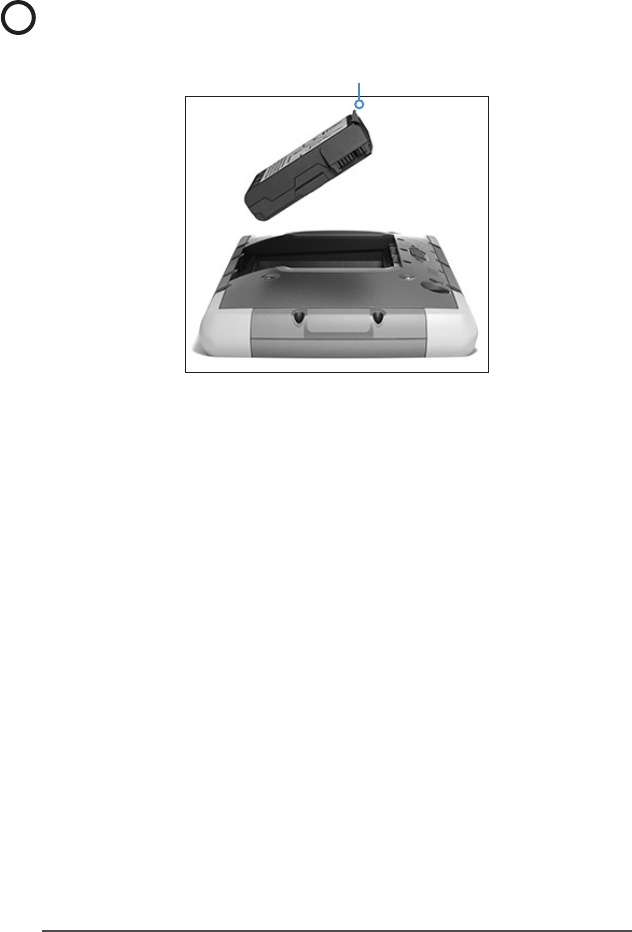
Chapter 1 Getting Started 5
Hold the battery so that the black tab on the front edge
of the battery is up and facing the door latch (this tab
helps you pull the battery out). Place the back edge
in rst, gently pushing it underneath the two battery
catches. Rotate the front edge down until it is in position.
CAUTION: Do not set the battery pack straight down.
Damage to the unit could occur.
4. Replace the door and press down on it until the latch
pops into the locked position.
5. Attach the appropriate plug for your country into the
AC wall charger and plug into a wall socket. Plug the
other end into the DC power jack on the Mesa 2.
Note: Use the AC wall charger that came with the
Mesa 2 or an approved charger. See Appendix C, Wall
Charger Warnings, for details.
6. Charge the battery pack at room temperature (68° F or
20° C) for 6 hours (for the rst charge). While the battery
pack is charging, the red LED blinks. When it is fully
charged and external power is applied, the red LED is
solid.
Note: If you have an optional internal battery as well as
a removable battery, the Mesa 2 will not recognize the
internal battery until the Mesa 2 is being charged and is
powered on.
!
Black Tab

6 Mesa 2 Rugged Tablet Owner’s Manual
Perform Set Up
1. Press the power key . The tablet powers on and begins
the startup process. The rst time the Mesa 2 is turned
on, A Getting ready screen comes up with a progress
indicator. This process can take a few minutes
2. Windows setup menus are presented for rst time set up.
- Pick your language (only those we have translated
the operating system into are listed here; for other
languages, see the next section), country, app
language, keyboard preference, and time zone.
- Read and accept the license agreement.
- To nish the setup process, you need internet access.
Pick the network you want to use. For Cellular, you
need to insert a SIM card (see Chapter 3, Optional
Features, 4G LTE Data Modem for details). For Wi-Fi,
you may need a security key.
- Select Express settings.
- Select the owner of the PC, My organization or I own it.
- If you selected My organization, choose how you will
connect to their infrastructure. In most situations, you
want to select Domain. We suggest you check with
your IT department. If you select yourself, go to the
next step.
- Connect to an existing Microsoft user account or
establish one. You can also chose to do this later if you
prefer.
2. You might be asked to restart the tablet to complete
installation.
3. The Microsoft Start screen appears in Tablet mode
which shows the Windows Start Menu with prominent
app tiles. Select the symbol in the upper left screen
to see the full Start Menu. If you prefer the traditional
desktop view, open the Action Center and select Tablet
mode which toggles it off. It stays off unless you toggle it
back on.
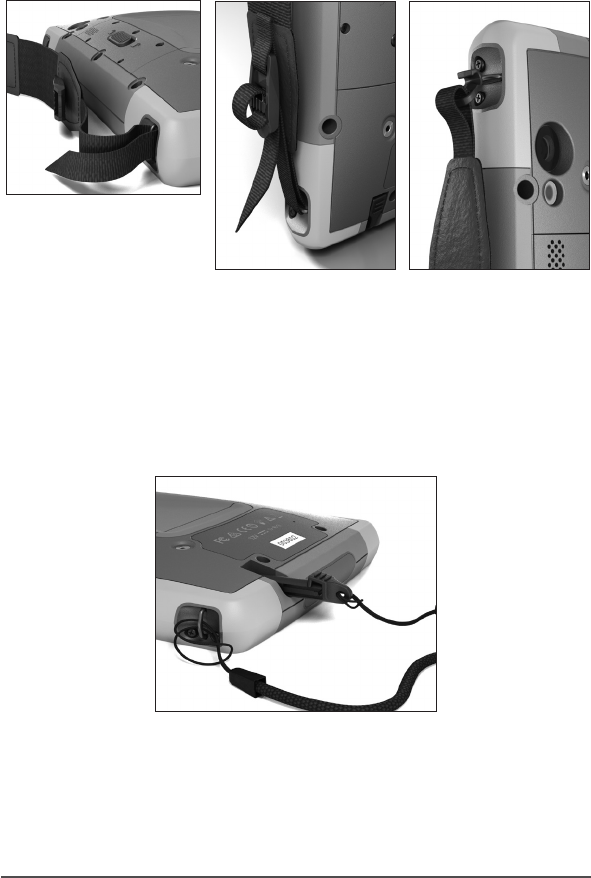
Chapter 1 Getting Started 7
Attach the Hand Strap and Stylus Tether
A hand strap, ne tip capacitive stylus, and tether are
included with the Mesa 2.
To attach the hand strap and tether to the Mesa 2, follow
the diagrams below. You can attach them to the right or left
side of the tablet:
1. Attach one end of the stylus tether to the stylus. To
attach the tether to the tablet, follow these steps:
2. Push the free tether loop through one of the tether
attachment points located on the side of any of the four
corners.
3. Insert the stylus with the attached tether through this
loop and tighten the loop.
1
2 3

8 Mesa 2 Rugged Tablet Owner’s Manual
4. Place the stylus into the stylus storage slot located on
the bottom of the Mesa 2.
Operating System Languages and Document
Updates
Install the Operating System in Other Languages
During the Windows set up process, you selected English or
one of the languages that the operating system has been
translated into, including the unique Mesa 2 operating
system features. Other languages are also available,
however the unique Mesa 2 operating system features are
shown in English and not the language selected.
From the Start screen, go to Settings > Time & Language >
Region & Language. Select your country or region from the
pull down list. Select the + symbol to see a list of possible
languages you can select from. You can also go to related
settings and make additional location related adjustments.
Updates to Technical Documents
Periodically check for updates to documentation associat-
ed with the Mesa 2 on our website at www.junipersys.com/
Juniper-Systems-Rugged-Handheld-Computers/products/
Mesa-2/Support. Compare part numbers or dates to see if
you have the most recent version of these documents.
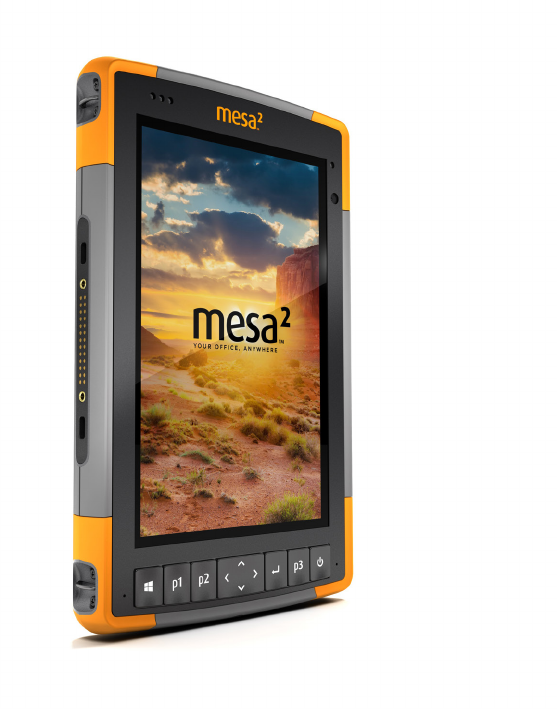
2
Standard
Features

10 Mesa 2 Rugged Tablet Owner’s Manual
Standard Features
This chapter discusses the standard features included with
every model of the Mesa 2 rugged tablet.
Windows 10 Pro Operating System
The Mesa 2 has the Windows 10 Pro operating system. If you
are not familiar with this operating system, we recommend
that you go to the Start menu > Get Started (you need
internet access to do this). Watch the videos and read the
text to familiarize yourself with Windows 10. You can also
go to Microsoft’s website from another computer to learn
about Windows 10.
Windows Start Menu
Press the Windows logo key or screen icon to open the
Start menu. All applications are listed here and you can
select Settings and File Explorer. Tiles provide easy access to
apps and can be customized.
Action Center
The Action Center provides quick controls, notications,
and messages. To view the Action Center, select the
Action Center icon on the bottom tray (located on the
far right end) or, from the right edge of the screen, swipe
left towards the center of the screen. The Action Center is
shown on the right hand side. Tiles are shown at the bottom.
Some are toggles like Tablet mode which toggles between
Tablet mode and the traditional desktop mode. Some tiles
take you to other screens where you can take action, like
Notes, or view other menus like All settings.
View System Information for Your Mesa 2
To view information about your Mesa 2 like the operating
system edition and OS build, go to the Action Center. Select
All Settings > System > About.
Display and Touchscreen
The Mesa 2 has a bright color display and capacitive
touchscreen with a diagonal viewing area of 7 inches
(178 mm). It is easy to view outdoors and is sealed against
water and dust. The Windows® 10 operating system

Chapter 2 Standard Features 11
enhances the ability of the Mesa 2 to recognize touch
gestures, making it easy to use a nger to make selections
and navigate. You can also use the ne tip capacitive
stylus included with the Mesa 2 or optimize it for rain (see
Touchscreen Settings in the next section).
Display and Touchscreen Prole Settings
Display Settings
To adjust the display settings including the text size,
brightness, and orientation, go to the Action Center and
select All settings > System > Display.
Backlight Brightness
There are a few shortcuts to adjust the display backlight
brightness.
Open the Action Center. Tap the percent tile (sun icon) to
toggle the display backlight brightness up or down in 25%
increments from 0% to 100%. This same tile can be accessed
by tapping the battery icon on the desktop. To simply dim
the backlight, tap the Battery saver tile. Tap it again to
return it to the previous brightness.
Display Magnier
To turn the magnier on, go to the Action Center and select
All settings > Ease of Use > Magnier. Turn the magnier on
and adjust other settings as desired. Once the magnier is
turned on, you can use the + and – symbols on the display
to zoom in and out.
If you use this feature frequently, you can set up a
programmable key to zoom in and out on the display. See
Keyboard Features, Programmable Keys later in this chapter
for more information.
Touchscreen Prole Settings
The touchscreen prole default is nger and stylus use. The
prole can be adjusted to wet, optimal nger, or optimal
stylus from the Touchscreen Proles app.
To adjust the touchscreen prole, go to the Start menu
and select Touchscreen Proles (located at the bottom of
the Start menu screen in a tile). Select the prole you want
the screen optimized for: nger and stylus (default), nger,
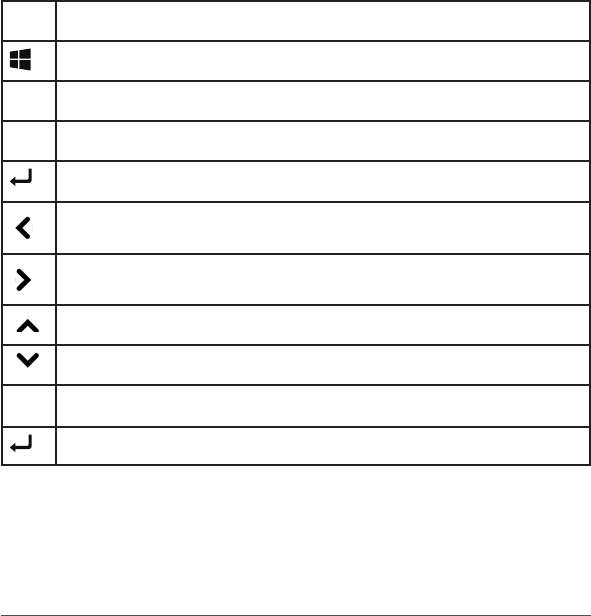
12 Mesa 2 Rugged Tablet Owner’s Manual
stylus, or wet conditions. As the new prole loads, a progress
bar is shown. Do not interrupt the loading process. You can
try different proles to see which one works best for you.
Calibration Tool - Do Not Use
The calibration tool in windows 10 is intended for a resistive
touchscreen. The Mesa 2 has a capacitive touchscreen.
If the Windows 10 screen calibration tool is used, it may
degrade touchscreen performance. Juniper Systems is
constantly trying to improve and update the quality and
responsiveness of the different touchscreen proles.
Keypad Features
The Mesa 2 has several programmable function keys, a
power/suspend key, windows key, and a navigation pad.
The keys are sealed and have backlight illumination. Some
keys are programmable.
Key Function
Windows Start screen
p1 Volume down (programmable)
p2 Volume up (programmable)
Enter (return)
Move left
Move right
Move up
Move down
p3 On screen keyboard (programmable)
Enter (return)
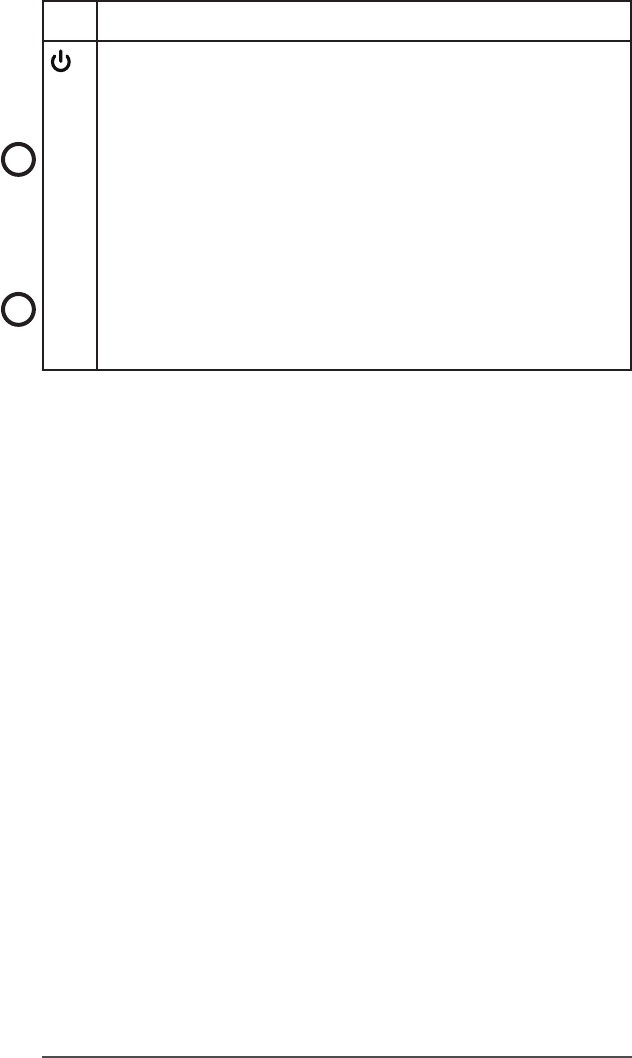
Chapter 2 Standard Features 13
Key Function
Power
Press and release: On or sleep
Hold for 5 seconds and pull down screen: Power
off
Hold for 10 seconds: Reset device. CAUTION:
before doing this, see the Sleep, Reset, Hibernate,
Power-Off, and Recovery section in this chapter.
Hold for 20 seconds: Electrically disconnect the
battery pack(s); to reconnect the batteries, you
are required to plug in the charger or external
12 V power. CAUTION: before doing this, see the
Sleep, Reset, Hibernate, Power-Off, and Recovery
section later in this chapter.
Programmable Keys
The p1, p2, and p3, function keys can be set up
programmatically. These keys can also be selected to
launch applications or functions.
To adjust the programmable keys, open the Start menu and
select Keypad Settings (located at the bottom of the Start
menu screen in a shortcut tile). The Keypad Buttons and
Backlight panel appears. The programmable keys and their
current assignments is shown. Select your preferred function
per key from the drop down menus.
Keypad Backlight Brightness
To adjust the keypad backlight brightness, go to the Start
menu and select Keypad Settings At the bottom of the
Keypad Buttons and Backlight panel is a slider that adjusts
the keypad backlight brightness. You can make the
backlight brighter by moving the slider to the right or turn it
down by moving the slider to the left. Dimming the keypad
backlight saves battery power when the Mesa 2 is in use.
Power Management
The Mesa 2 runs on battery power. It comes with a Li-Ion
rechargeable and removable battery pack. An internal
battery pack is an option. You can use one type of battery or
both.
!
!

14 Mesa 2 Rugged Tablet Owner’s Manual
Battery Status and Management
To nd out how much battery life you have left, tap on
the battery icon at the bottom of the desktop screen. The
amount of charge left as a percent and the status of each
battery is shown. The cumulative amount of battery life
left for installed batteries and the approximate amount
of time battery power will last is also shown. (This is an
approximation. The amount of time left varies depending
on what you are doing with the unit).
Preserving Battery Power
There are some settings you can adjust to preserve battery
power. From the battery screen the display backlight
brightness can easily be toggled up or down in 25%
increments from 0% to 100% by tapping the percent tile (see
the sun icon). Tap the Battery saver tile to dim the backlight
or return it to the previous brightness. To make additional
adjustments, select Power and sleep settings. Settings like
how much time passes before the tablet turns off or goes to
sleep and whether or not Wi-Fi stays connected while it is
asleep can be adjusted.
Charging the Battery Pack(s)
For instructions on how to insert and charge the removable
battery pack, refer to the instructions in Chapter 1, Getting
Started. It typically takes 4 to 5 hours to fully charge a battery
pack.
For tablets that have both a removable battery pack and
an optional internal battery pack, the intelligent internal
battery charging circuit rst charge the battery pack with
the least amount of energy. When this battery pack comes
to the same level as the other battery pack, then both
battery packs are charged at the same time until they are
both fully charged.
Battery packs are charged most efciently at room
temperature (68° F or 20° C). They will not charge if it is too
hot or too cold.
We recommend that you keep the tablet battery pack(s)
charging when it is not in use for up to two weeks. When you

Chapter 2 Standard Features 15
plug the tablet into the wall charger that comes with it, the
batteries are prevented from being overcharged.
CAUTION: Always power off the tablet before removing
the battery. Failure to do so may cause loss of data or
damage to the tablet. EXCEPTION: If your tablet has an
internal battery, this caution does not apply. You can
safely remove (hot swap) the removable battery while the
unit is running.
CAUTION: The Mesa 2 is not sealed against water and dust
when the battery or battery door is not installed properly.
Battery Life
Battery life on a full charge can be 20 hours or more. This
varies depending on whether or not you also have an
optional internal battery, the applications used, backlight
usage, and radio usage. The optional internal battery adds
5-6 extra hours of battery life.
The shelf life of a battery is about one year (they come
from the manufacturer charged to 50%). Battery packs last
approximately 1,000 to 3,000 charging cycles before they
need to be replaced. This is impacted by applications and
environmental factors. The optional internal pack should last
for the life of the Mesa 2.
CAUTION: Only use batteries designed for the Mesa 2 from
an approved vendor. Use of non-approved batteries may
void your product warranty. The Mesa 2 must be returned to
the factory for replacement of the optional internal battery,
although the internal battery pack is designed to last the
life of the tablet.
Power States
The Mesa 2 runs on battery power, or external power. If
external power is used, a replaceable and/or internal
battery must be installed.
CAUTION: The unit is not designed to run on external power
without a battery installed. Doing so can damage internal
components of your unit and void the warranty.
!
!
!
!

16 Mesa 2 Rugged Tablet Owner’s Manual
You can adjust some settings to preserve power:
Turn off the display (suspend) after a set interval.
Disable radios when not in use.
Turn down the display and keypad backlights.
LED Activity Indicators
LED activity indicators are located on the front of the Mesa
2 in the upper-left corner.
Red LED, solid: 1) When the Mesa 2 is put to sleep or
powered off by pressing the power key (see details
later in this chapter), the red LED is solid until the unit
has successfully completed the process, and then the
red LED turns off. (The battery should not be removed
while the light is solid until the process is complete.) 2)
The AC adapter is plugged in and the battery is full (not
charging). Red LED, blinking: The AC adapter is plugged
in and the battery is in the process of charging.
Green LED, solid or blinking: Programmable.
Blue LED, solid or blinking: Programmable.
Amber Light: Front or rear facing camera is in use.
The green and blue LEDs are in the same location. They
can not be shown simultaneously. These LEDs can be
programmed by a developer. Sample code is available
upon request
Light Sensor
All units have an ambient light sensor located on the front
of the Mesa 2 in the upper-right corner. The light sensor
dynamically adjusts the backlight on the display.
You can disable this process and manually control the
display brightness if you prefer. Go to the Start menu
and select Settings > System > Display. Turn off Change
brightness automatically when lighting changes and tap
Apply. To manually adjust the display backlight, tap on
the battery icon at the bottom of the desktop screen. The
display backlight brightness can easily be toggled up or
down in 25% increments from 0% to 100% by tapping the
percent tile (see the sun icon).
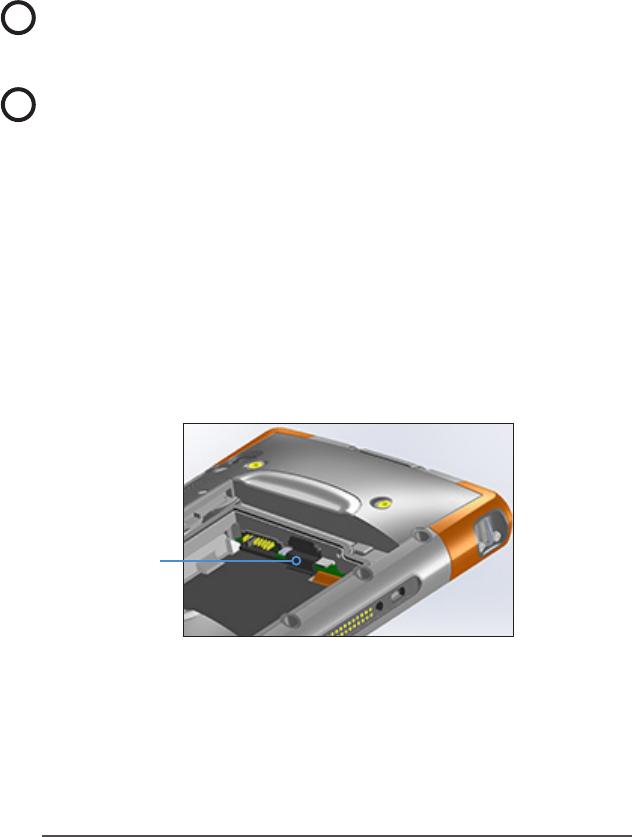
Chapter 2 Standard Features 17
SD Cards
The Mesa 2 has a slot for a micro SD card located in the
battery compartment. The card slot and exible card
holder are designed to hold the card securely in place so it
will not come out or disconnect if the tablet is dropped. To
insert or remove a card follow these step:
1. Power off the tablet.
2. Remove the battery door as outlined in chapter 1.
CAUTION: The Mesa 2 is not sealed against water and
dust when the battery pack and battery door are not
installed properly.
CAUTION: Always power off the tablet before removing
the battery. Failure to do so may cause loss of data or
damage to the tablet. EXCEPTION: If your tablet has an
internal battery, this caution does not apply. You can
safely remove the removable battery while the unit is
running.
3. Remove the battery pack by pulling up on the black tab
on the battery pack.
4. An image on the battery compartment label shows the
correct location and orientation for the SD card (slot on
the right). Pull the exible card holder back out of the
way. Push the card into the slot to insert it.
5. Push the exible card holder back into place, covering
the card slots.
6. Replace the battery pack, and attach the battery door.
To remove the SD card, pull it out. Use tape or an eraser if
you have trouble.
!
!
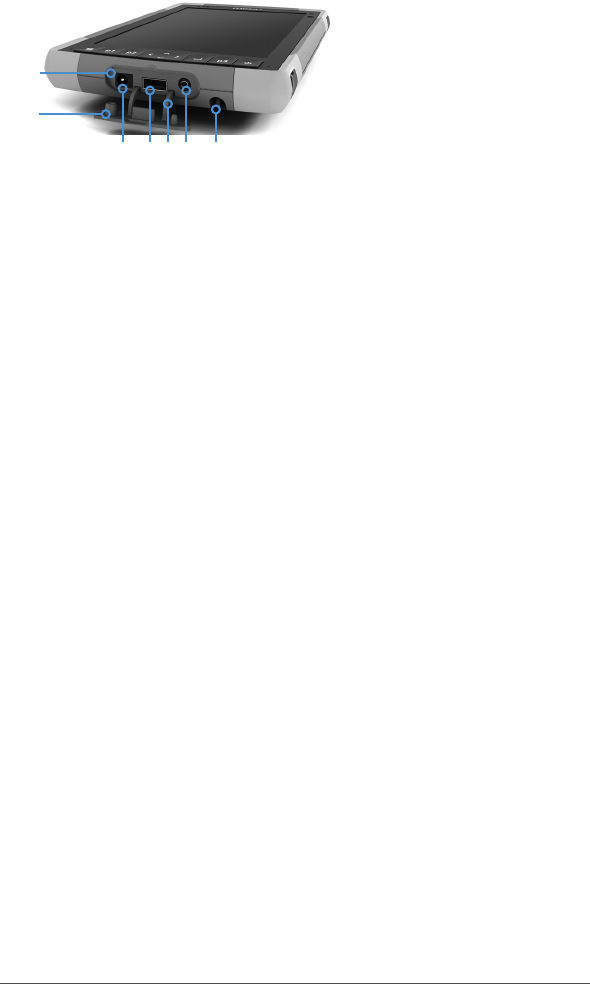
18 Mesa 2 Rugged Tablet Owner’s Manual
Connector Ports
The Mesa 2 has the following jacks and connectors:
The connector protector is removable and replaceable.
See your sales representative for if you need a new one. To
remove it, pull it out of the ports, then gently pull the curved
rubber retainers out of the holes they are in. Replace it by
inserting the curved rubber retainers back into the holes.
Note: The connectors are sealed. A connector protector
to not required to prevent water ingress. It protects the
connectors from exposure to excessive dust and dirt.
Audio Features
The Mesa 2 has the following audio features (see The
Anatomy of the Mesa 2 images for the locations of these
items):
Speaker - The speaker provides audible indicators
and program feedback. You can listen to mono audio
les and watch video. For stereo audio, use Bluetooth,
headphones or HDMI output from the optional dock.
Microphone - Use the microphone to record audio notes
or add sound to a video when using the camera (option).
Built in microphones can also be used for Skype calls.
Audio Jack - The audio jack supports a stereo headset
or headset/microphone combination with 3.5 mm
connections.
1 Connector Ports
2 Connector Protector
3 12 V DC Power Input Jack
4 USB Host, Full Size
5 Connector Protector Retainer
6 Microphone/Speaker Jack
7 Stylus/Storage Slot
1
3 4 6
2
7
5

Chapter 2 Standard Features 19
Sleep, Reset, Hibernate, Power-Off, and Recovery
Putting the Mesa 2 to Sleep
The Mesa 2 goes to sleep after 10 minutes by default. When
the tablet is in a sleep state it is still powered up, but in a low
power state.
1. To put the Mesa to sleep, press and release the power
key or go to the Start menu, select the Power symbol,
and select Sleep. Going into a sleep state can take
several seconds, depending on which activities the
tablet is working on at the time. While it is going to sleep,
the red LED remains lit.
2. To wake the tablet from a sleep state, press and release
the power key again. When it is awakened, the tablet
quickly resumes where it was before it was put to sleep.
3. You can change the sleep default setting by going to
the Start menu and selecting Settings > System > Power
and Sleep > Sleep.
Hibernating the Mesa 2
The Mesa 2 can be set up to hibernate, which powers down
the Mesa 2. The state of the tablet is saved to a special
le. When the tablet is powered up, the unit boots, sees
the special le, and restores everything to the state it was
in before it hibernated. This is a safer choice versus sleep
if battery power is a concern. For example, your battery is
fairly consumed, but you won’t have access to the charger
for a while. Hibernate will stretch your battery life out.
By default, when the Mesa 2 is powered off, it goes to sleep.
You can change this setting to hibernate (or other options).
Open the Start menu and select Settings, then go to System
> Power and sleep. At the bottom of the screen under
Related settings, select Additional power settings > Choose
what the power button does. Under Power button settings,
When I press the power button: select Hibernate from the
pull down lists for the On battery and Plugged in options.
Powering Off and On the Mesa 2
To preserve battery power, we recommend you power off
the Mesa 2 if it will not be used over a long weekend or

20 Mesa 2 Rugged Tablet Owner’s Manual
several days. Remember that when a unit is powered off
it is still operating, though at a low power state, and this
consumes battery power.
CAUTION: Be aware that when the Mesa 2 is powered
off, it closes all programs and powers down all system
components. If hibernate is not used, all programs are
closed and data may be lost.
1. Save open les, and close any running programs.
2. Go to the Start menu, select the Power symbol, and
select Shut Down. If the Start menu is not available, press
and hold the power key for 5 seconds and slide the
screen that drops down towards the bottom of the Mesa
2 screen.
3. On battery power, if typically takes about 30 seconds for
the tablet to completely shut down, although it can take
several minutes.
4. To power on the Mesa 2, press the power key.
Ctrl-Alt-Delete Function
Press and hold down the Microsoft key, then press the On
key. A list that includes the Task Manager is shown. Select
Task Manager to see which apps are running. Press More
details at the bottom to view Processes, Performance, and
other items. This can be useful if your Mesa 2 is not acting
correctly and you want to do some troubleshooting.
Resetting the Mesa 2
If the Mesa 2 is unresponsive, slow, or programs won’t
launch, performing a reset might solve the issue. You
might be asked to perform a reset when an application is
installed.
CAUTION: Be aware that during a reset, applications are
closed and unsaved work may be lost.
To reset your Mesa 2, Go to the Start menu, select the Power
symbol, and select Restart.
Mesa 2 is Locked Up
If the Mesa 2 is completely stuck and won’t respond or you
cannot get to the Start menu, hold the power key down for
!
!

Chapter 2 Standard Features 21
ve seconds to see if that solves it. If that doesn’t work, hold
it down for 10 seconds. This causes a hardware shut off.
If 10 seconds doesn’t work, hold the power button down for
20 seconds. Batteries are forced to electrically disconnect
from the tablet, causing a complete shut down. The tablet
cannot be powered on again until it is plugged in with the
AC adapter. Keep this in mind if you are in the eld.
CAUTION: Holding the power button down for 20 seconds
for a forced disconnect is recommended only as a last
resort. It can be very hard on the system hardware. NEVER
do this to power off or reset a Mesa 2.
Recovery Image
You can restore the Mesa 2 back to the factory defaults
using the Recovery Image.
Before initiating a recovery, make sure that the tablet is
plugged in. Go to the Start Menu and select Settings >
Update & Security > Recovery > Reset This PC > Get Started.
Choose Keep my les or Remove everything depending on
your personal needs. A verication screen asks you to verify
what you want to do with the existing les. The recovery
process can take up to 3 hours.
Sensors
Compass, Accelerometer, and Gyroscope
The Mesa 2 has a built-in compass and accelerometer. The
accelerometer assists the compass in determining direction,
even when the device is not resting at. The gyroscope
senses change in motion. The compass, accelerometer,
and gyroscope can also be used by other user applications.
The sensors in the Mesa 2 have been factory calibrated.
Periodic user calibrations helps the compass be calibrated
to the environment it is being used in. Move the device
though all orientations and angles.
Bluetooth® Wireless Communication
The Mesa 2 has built-in Bluetooth® wireless technology,
allowing you to connect it to other wireless devices with
Bluetooth technology.
!

22 Mesa 2 Rugged Tablet Owner’s Manual
Creating a Partnership/Pairing a Bluetooth Device
To create a partnership between the Mesa 2 and another
device with Bluetooth technology:
1. Turn both devices on.
2. Place them within a few feet of each other. (The Mesa
has long range Bluetooth, but the other device might
not.)
3. Make Bluetooth discoverable on both devices. Bluetooth
on the Mesa 2 is off by default. To activate it, open the
Action Center and press and hold the Bluetooth icon.
Select Go to settings.
4. In the Bluetooth settings screen you should see a list of
all Bluetooth devices within range. Tap on the name of
the device in the list you would like to pair with, then tap
Pair. If prompted enter the Pin or Passcode of the paired
device. You should now be paired with the device.
Note: If Bluetooth is on and the tablet enters sleep or
hibernate mode, Bluetooth turns off to save battery power.
The connection is resumed once it powers back on.
Wi-Fi Wireless Networking
The Mesa 2 has built-in Wi-Fi wireless networking to connect
to the Internet or an ofce network.
Connecting to a Wi-Fi Network
To use Wi-Fi, you need to be in range of a Wi-Fi access
point to make a connection. When Wi-Fi is turned on (the
default), the Mesa 2 automatically starts scanning the area
for available Wi-Fi networks.
From the Action Center click and hold the Wi-Fi network
icon, then select go to settings. A list of available networks
is shown. Select the network you want to use and enter
the network security key. The Mesa 2 remembers the Wi-Fi
network connections created.
Wi-Fi can be turned off and on and settings can be
managed from this set up screen.
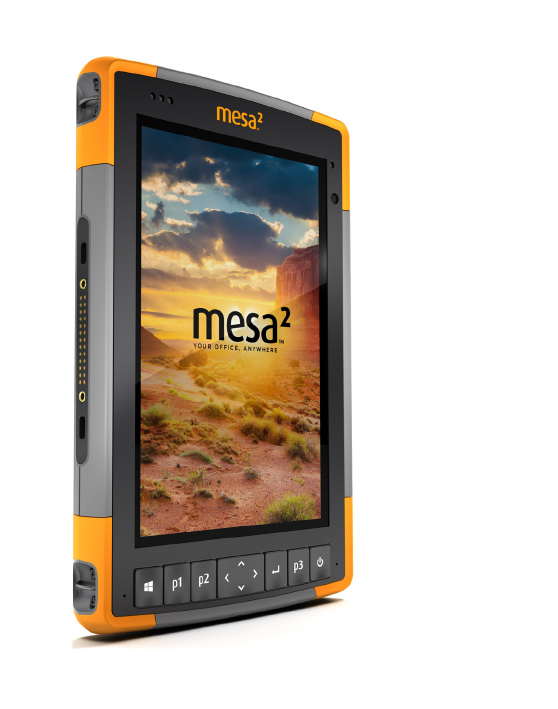
3
Optional
Features

24 Mesa 2 Rugged Tablet Owner’s Manual
Optional Features
This chapter discusses the optional features that can be
included with the Mesa 2 rugged tablet.
GPS/GNSS
Mesa 2 Geo models have GPS/GNSS with 2 to 5 meter
accuracy. Use Maps to see your location and insure that
GPS is working. Open the Start menu and select Maps from
the Most used apps list.
GPS/GNSS Support
Integrated GPS/GNSS Support in Windows
The Windows operating system provides built-in support for
GPS/GNSS devices. As part of that support, the Windows
Sensor and Location platform provides a standard way
for GPS/GNSS information to be made available to
applications that have been designed using the Windows
Sensor and Location application programming interfaces
(APIs).
Legacy Support
In addition to the Sensor and Location APIs, legacy
applications that require access to a serial port can access
NMEA data through a serial COM port interface. The name
of the COM port can be found by using Device Manager
and looking under Ports (COM & LPT) for “u-blox Virtual
COM port (COMx) where “x” is the port number allocated
on your device.
GPS/GNSS Accuracy
The GPS/GNSS antenna is under the notication LEDs and
is intended to work in both portrait view and landscape
view. Do not put your hand or another object over this area.
Accuracy could be reduced. The more items between the
antenna and the satellites, the lower the accuracy.

Chapter 3 Optional Features 25
Camera
Mesa 2 Geo models have a front facing camera that is 2 MP
and a rear facing camera that is 8 MP.
The camera app is accessed from the Start menu, All apps
> Camera. There is also a camera tile in the Start menu. You
can set up a programmable key to launch the camera app
if you desire. See Chapter 2, Standard Features, Keyboard
Features, Programmable Keys for more information.
Both the still image camera and video camera are
available from this screen. Other options like audio and a
ash are shown at the top of the camera screen.
Audio
You can record sound with videos. From the Video screen,
tap Include audio when recording video les to turn audio
on.
Photo and Video Library
Photographs and videos are automatically stored in the
Pictures folder.
4G LTE Data Modem
The 4G LTE data modem is an option for Mesa 2 Geo
models, adding Wide Area Network data modem
capability.
This modem supports all major service providers in North
America, Europe, and many other regions of the world.
Refer to frequency bands and modes supported by the
Mesa 2 located in Appendix D, Specications, and your
service provider of choice for compatibility.
Set up a Data Account with a Wireless Provider
Contact a wireless provider to set up data service for the
cellular data modem and obtain an account and micro SIM
card. You need to provide the following information when
setting up an account:
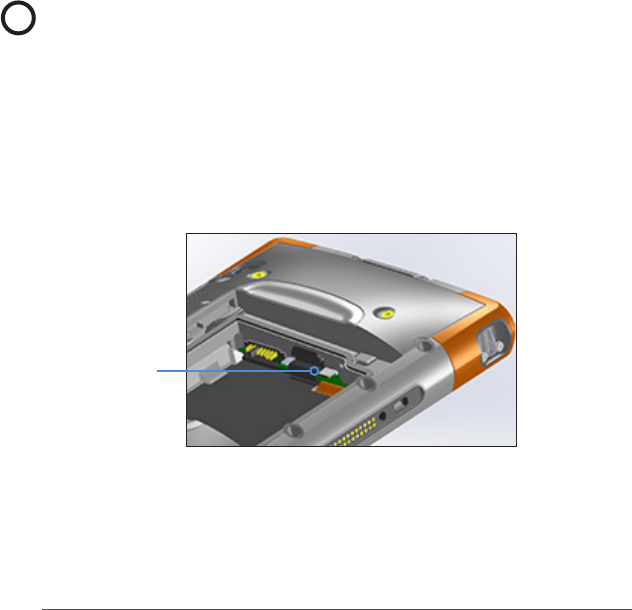
26 Mesa 2 Rugged Tablet Owner’s Manual
1. Billing Information and business ID, such as your Federal
Tax I.D. or VAT number.
2. The wireless services required. Specify that you need
data service only. You do not need voice or messaging
services.
3. You may be asked for the modem’s IMEI number. From
the Start menu, select Settings > Network & Internet >
Cellular. Tap on the Cellular icon, then select Advanced
Options. The IMIE number is listed under Properties.
Install the SIM Card
The card slot and exible card holder are designed to
hold the card securely in place so it will not come out or
disconnect if the tablet is dropped. To insert or remove a
card follow these step:
1. Power off the tablet (this is a requirement).
2. Remove the battery door as outlined in chapter 1.
CAUTION: The Mesa 2 is not sealed against water and
dust when the battery door is not installed properly.
3. Remove the battery pack by pulling up on the black tab
on the front of the battery pack.
4. An image on the battery compartment label shows the
correct location and orientation for the SIM card (slot on
the right). Pull the exible card holder back out of the
way. Push the card into the slot to insert it.
!

Chapter 3 Optional Features 27
5. Push the exible card holder back into place, covering
the card slots.
6. Replace the battery pack, and attach the battery door.
To remove the SIM card, gently pull it out with tweezers or a
piece of tape.
Note: If the modem was on before shutting the Mesa 2
down to insert the SIM card, you are prompted to congure
the data connection when you reboot.
Wireless Safety
RF Interference Issues
It is important to follow any special regulations regarding
the use of radio equipment due in particular to the
possibility of radio frequency (RF), interference. Here are
some examples:
Switch OFF your cell modem in hospitals and any other
place where medical equipment may be in use.
Respect restrictions on the use of radio equipment in fuel
depots, chemical plants or where blasting operations are
in progress.
Operating your cell modem close to inadequately
protected personal medical devices, such as hearing
aids and pacemakers, could be hazardous. Consult the
manufacturers of the medical device to determine if it is
adequately protected.
Operation of your cell modem close to other electronic
equipment may also cause interference if the equipment
is inadequately protected. Observe any warning signs
and manufacturers’ recommendations.
Do not place the Mesa 2 with a cell modem alongside
computer discs, credit or travel cards, or other magnetic
media. The modem may affect the information
contained on discs or cards.
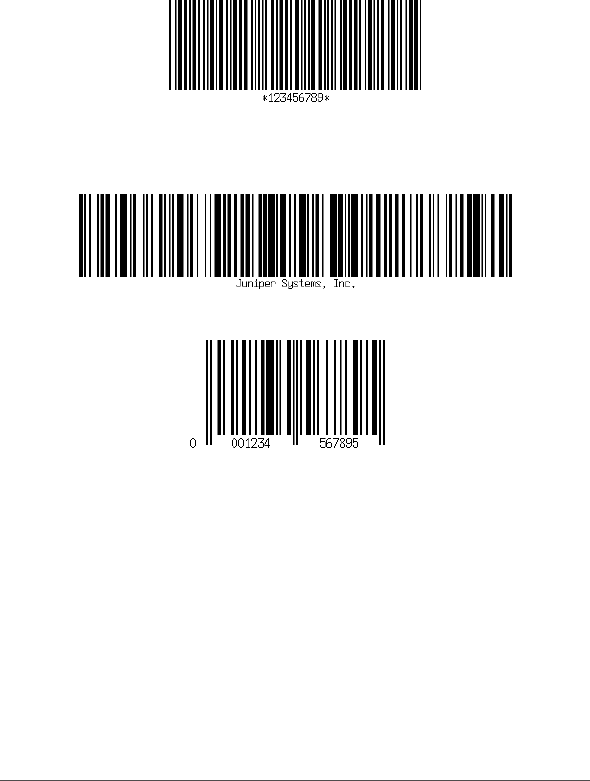
28 Mesa 2 Rugged Tablet Owner’s Manual
Barcode Scanner
The Mesa 2 Rugged Tablet with a barcode scanner allows
you to read 1D and 2D barcodes and easily import barcode
data into custom or standard programs running on the
Mesa 2.
There are third party barcode scanning applications
available.
Sample Barcodes
1D Barcodes
Code 39
Code 128
UPC-A
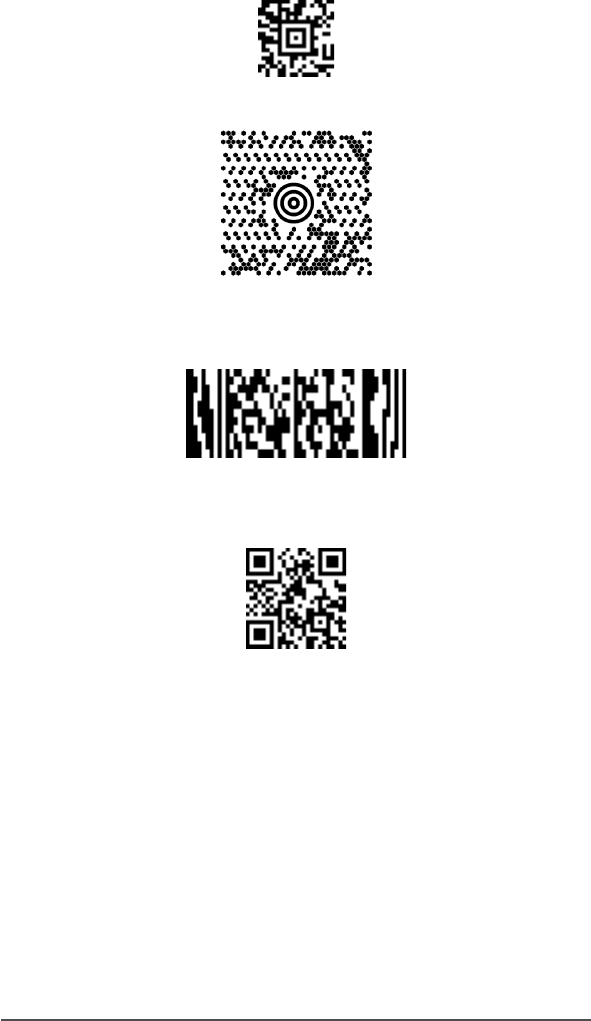
Chapter 3 Optional Features 29
2D Barcodes
Aztec
Maxicode
MicroPDF417
QR Code

30 Mesa 2 Rugged Tablet Owner’s Manual
RFID Reader
The Mesa 2 with an UHF RFID Reader allows you to read
UHF EPC Gen 2 RFID tags and easily import tag data into
programs running on the Mesa.
There are third party RFID scanning applications available.
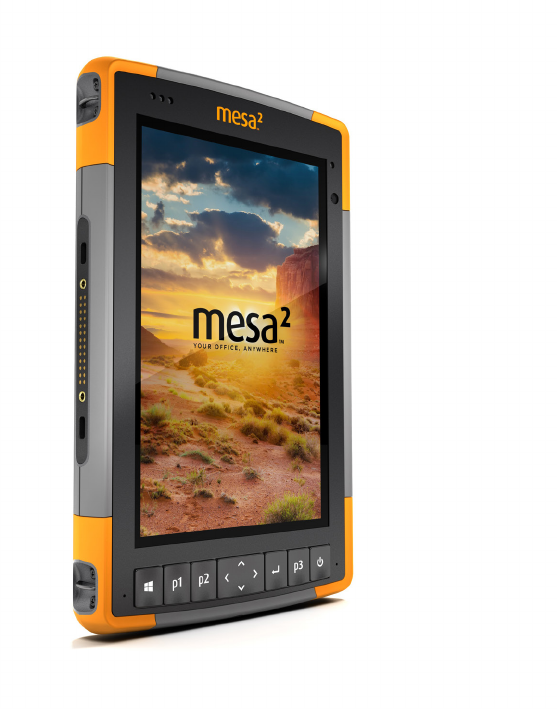
A
Storage,
Maintenance,
and Recycling

32 Mesa 2 Rugged Tablet Owner’s Manual
Storage, Maintenance, and Recycling
Follow the instructions in this chapter to properly maintain
and recycle the Mesa 2.
Storing the Mesa 2 and Battery Pack
When the tablet is not being charged and is in a sleep state,
it draws a small amount of power. This power draw is used to
maintain the memory (RAM) of the tablet in the same state it
was in when it was awake. We recommend charging the tablet
each night or weekend when it is in a sleep state.
If the Mesa 2 is not charged while in a sleep state and the
battery reaches a low charge, it automatically powers off to
prevent further drain on the battery.
Note: Data and programs are secure as long as they have
been saved, even if the battery pack becomes discharged.
The tablet does not depend on the battery to store the data
for extended periods.
Storing the Mesa 2 for Less Than Two Weeks
To store the tablet for less than two weeks, complete the
following steps:
1. Close all applications.
2. Plug the tablet into the AC wall adapter that was
shipped with your unit.
Storing the Mesa 2 for More than Two Weeks
To store the tablet for two weeks or more, complete the
following steps:
1. Charge the battery pack 30 to 50 percent.
2. Close all running programs, and turn off the tablet.
3. Remove the battery pack.
4. If you have an internal battery pack, Press and hold the
power button for 20 seconds to disconnect it.
5. Place the battery pack in a cool, dry location.
6. The AC adapter must be plugged in and connected to
the Mesa 2 in order to turn it on after storage.

Appendix A Storage, Maintenance, and Recycling 33
Protecting the Touchscreen
Protect the touchscreen from impact, pressure, or abrasive
substances that could damage it. To further protect the
touchscreen, apply a screen protector (optional accessory)
using the directions that come with it in the package.
CAUTION: Be sure to replace the screen protector as often
as the screen protector instructions recommend.
Cleaning the Mesa 2
Make sure the battery door is securely installed. Remove
the screen protector if you want to clean underneath it.
Use warm water, a mild cleaning solution, and a soft bristle
brush to gently clean the Mesa 2.
CAUTION: Do not direct a high-pressure stream of water
at the device to clean it. This action could break the seal,
causing water to get inside the device and voiding the
warranty.
CAUTION: Exposure to some cleaning solutions may
damage your device, including automotive brake cleaner,
isopropyl alcohol, carburetor cleaner, and similar solutions.
If you are uncertain about the strength or effect of a
cleaner, apply a small amount to a less visible location as a
test. If any visual change becomes apparent, promptly rinse
and wash with a known mild cleaning solution or with water.
Recycling the Mesa 2 and Batteries
When the Mesa 2 reaches the end of its life, it must not be
disposed of with municipal waste. It is your responsibility
to dispose of your waste equipment by handing it over to
a designated collection point for the recycling of waste
electrical and electronic equipment.
The Li-Ion battery packs for your Mesa 2 are recyclable.
!
!
!

34 Mesa 2 Rugged Tablet Owner’s Manual
Avoid placing them in the trash or municipal waste system.
To nd the nearest battery recycling center in the USA,
you can contact the Rechargeable Battery Recycling
Corporation’s at 1-877-723-1297.
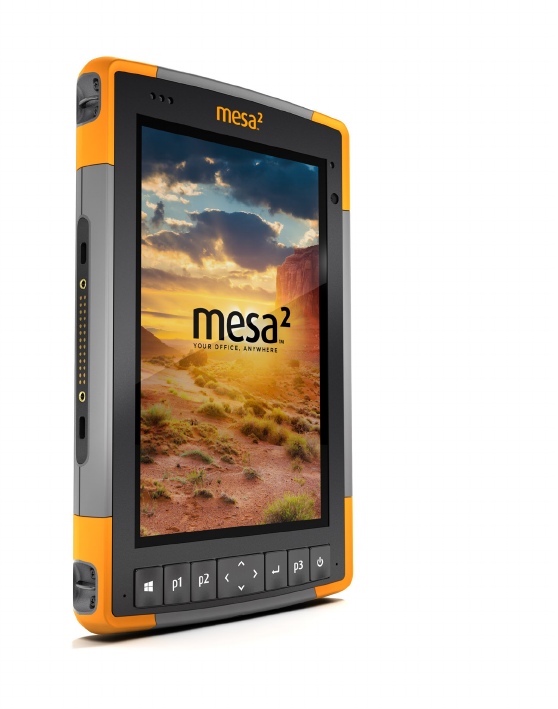
B
Warranty
and Repair
Information

36 Mesa 2 Rugged Tablet Owner’s Manual
Warranty and Repair Information
Limited Product Warranty
Two Year Warranty
Juniper Systems, Inc. (“JS”) warrants that the Mesa 2
Rugged Tablet and optional internal battery shall be free
from defects in materials and workmanship, under normal
intended use, for a period of 24 months from the date of
shipment, excepting that this warranty shall not apply to
user replaceable battery packs, media containing tablet
and desktop PC programs, user documentation, and any
accessories
Ninety Day Warranty
JS warrants that the following items shall be free from
defects in materials and workmanship, under normal
intended use, for a period of ninety (90) days from the date
of shipment:
User replaceable battery packs
Media containing the Mesa 2 and desktop computer
programs
User documentation
Accessories
Warranty Exclusions
This warranty shall not apply if:
(i) the product has been set up improperly or has been
improperly installed or calibrated,
(ii) the product is operated in a manner that is not in
accordance with the user documentation,
(iii) the product is used for a purpose other than for which it
was designed,
(iv) the product has been used in environmental conditions
outside of those specied for the product,
(v) the product has been subject to any modication,
alteration, or change by or on behalf of customer
(except and unless modied, changed or altered by JS
or under direct supervision of JS),

Appendix B Warranty and Repair Information 37
(vi) the defect or malfunction results from misuse or
accident,
(vii) the serial number on the product has been tampered
with or removed, or
(viii) the product has been opened or tampered with in any
way (such as the tamper evident VOID label indicating
certied IP [Ingress Protection] seal area has been
tampered with or removed).
Parts that are excessively worn are not covered under
warranty. These may include, but are not limited to, the
keyboard elastomer and switch matrix, hand straps, and
the touch screen (if applicable).
This warranty is exclusive and JS will not assume and hereby
expressly disclaims any further warranties, whether express
or implied, including, without limitation, any warranty as
to merchantability, tness for a particular purpose, non-
infringement or any warranties arising from the course of
performance, dealing, or usage of trade. JS specically
makes no warranties as to the suitability of its products for
any particular application. JS makes no warranties that
its products will meet your requirements or will work in
combination with any hardware or applications software
products provided by third parties,
the operation of its products will be uninterrupted or error
free, or
all defects in the product will be corrected.
JS shall not be responsible for software, rmware, information,
or memory data contained in, stored on, or integrated with
any products returned to JS for repair, whether under warranty
or not.
Remedy
In the event a defect in materials or workmanship is
discovered and reported to JS within the specied warranty
period, after evaluation by a technician at a certied repair
center, JS will, at its option, repair the defect or replace the
defective part or product. Replacement products may be
new or reconditioned. JS warrants any replaced or repaired

38 Mesa 2 Rugged Tablet Owner’s Manual
product for a period of ninety (90) days from the date of
return shipment, or through the end of the original warranty
period, whichever is longer.
Limitation of Liability
To the fullest extent allowed by law, the obligation of JS
shall be limited to the repair or replacement of the product.
JS shall in no event be liable for special, incidental, or
consequential, indirect, special or punitive damages of any
kind, or for loss of revenue or prots, loss of business, loss of
information or data, or other nancial loss arising out of or
in connection with the sale, installation, maintenance, use,
performance, failure, or interruption of any product. Any
responsibility and/or liability of JS shall, in connection with a
warranted product, be limited in the maximum amount to
the original purchase price.
Governing Law
This warranty is governed by the laws of Utah, U.S.A. and
excludes the United Nations Convention on Contracts for
the International Sale of Goods. The courts of Utah shall
have exclusive personal jurisdiction in case of any disputes
arising out of or in connection with this warranty.
Warranty Repairs
Warranty information for the Mesa 2 Rugged Tablet is
located on our website at http://www.junipersys.com/
Juniper-Systems-Rugged-Handheld-Computers/support/
Warranty. You can evaluate and order service plans, check
warranty status, and view warranty terms and conditions.
To obtain warranty repair, paid upgrade, or service on the
Mesa 2, submit a Repair (RMA) Request Form on our website
at https://www.junipersys.com/design/junipersys/rma_
request.php and ll out or contact an authorized repair
center within the applicable warranty period.
Standard repair orders and 3-Day Expedite Service repair
orders are valid for 30 days from the date issued. 1-Day
Expedite Service repair orders are valid for 7 days from the
date issued. If you will not be sending the product to us
immediately, please wait to request a repair until closer to
the time when you are ready to send us the product.

Appendix B Warranty and Repair Information 39
Services and Materials Provided Under Warranty
Analysis of problem by service technician
Labor and materials required to x defective parts
Functional analysis performed after repair
Shipping costs to return device to customer
JS strives to provide continued full repair services for our
products for ve years or more from the nal production
date of each product model. However, in some rare cases
(depending on the repair need), it may not be possible
to perform a repair due to an unforeseen discontinuation
or lack of supplied parts from third-party vendors. Repair
support for a product may continue beyond ve years if
obtaining replacement parts or tools remains economically
feasible. Our policy is that we will do what is best and most
benecial for our customers and company.
Complete Care Service Plans
We offer service plan options that provide additional
benets through participating repair centers. Services
include:
Service plan coverage up to ve years from the original
product ship date
Up to a 50% discount on all charged repairs
Expedited repairs and return shipping at no additional
charge
Replacement of worn and/or damaged parts at no
additional charge
Complete comprehensive coverage to protect your
investment even when accidents occur
Loaner product option when an expedited repair is not
enough
Priority support through a personal account specialist
For more information about our Complete Care service
plans, go to our website at http://www.junipersys.com/
Juniper-Systems-Rugged-Handheld-Computers/support/
Warranty.

40 Mesa 2 Rugged Tablet Owner’s Manual
Repairs, Upgrades, and Evaluations
CAUTION: Do not attempt to repair the Mesa 2 yourself. This
action voids the warranty.
Information about repairs, upgrades, and evaluations is
located on our website at http://www.junipersys.com/
Juniper-Systems/support/Repairs. You can locate a repair
center, submit a repair order, check repair status, view terms
and conditions, get shipping instructions, and view lead
times.
Before returning a unit, please get permission by submitting
a repair order from our website and waiting for conrmation
or by contacting a repair center directly. Be prepared to
provide the following information:
The product serial number. Information about your Mesa
2 is shown when you go to the Action Center and select
All Settings > System > About. The serial number is located
inside the battery compartment as well.
Note: Before opening the battery door and removing the
battery, see the proper procedure in Chapter 1, Getting
Started and Chapter 2, Power Management.
Name and shipping address of company/university/
agency.
Best contact method (phone, fax, email, cell/mobile).
Clear, highly-detailed description of the repair or
upgrade.
Credit card/ purchase order number and billing address
(for a repair or upgrade that is not covered by the
standard warranty or an extended warranty policy).
System Information for your Mesa 2
You might be asked to provide additional information
about your Mesa 2 when you contact a repair center. To
view information like the operating system edition, OS build
and serial number, go to the Action Center and select All
Settings > System > About.
!
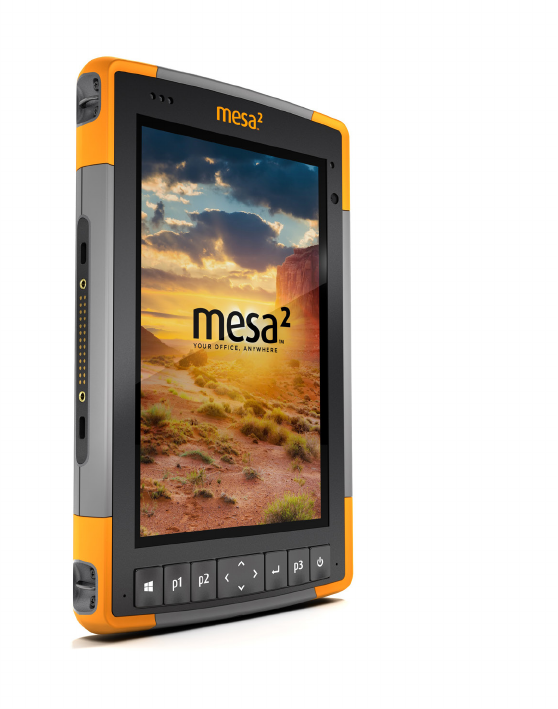
C
Warnings,
Regulatory
Information,
Licensing

42 Mesa 2 Rugged Tablet Owner’s Manual
Warnings, Regulatory Information,
Licensing
Product Warnings
Follow the warnings listed below to use the Mesa 2 and
accessories safely.
Battery Warnings
WARNING! This device comes with a lithium-ion
rechargeable battery pack. To reduce the risk of re or
burns, do not disassemble, crush, puncture, short external
contacts, or expose the battery pack to re.
Do not disassemble or open, crush, bend or deform,
puncture or shred.
Do not modify or remanufacture, attempt to insert foreign
objects into the battery, immerse or expose to water or
other liquids, expose to re, explosion or other hazard.
Only use the battery for the system for which it is specied.
Only use the battery with a charging system that has
been qualied with the system per this standard. Use of an
unqualied battery or charger may present a risk of re,
explosion, leakage, or other hazard.
Do not short circuit a battery or allow metallic conductive
objects to contact battery terminals.
Replace the battery only with another battery that has
been qualied with the system.
Use of an unqualied battery may present a risk of re,
explosion, leakage or other hazard.
Promptly dispose of used batteries in accordance with local
regulations.
Battery usage by children should be supervised.
Avoid dropping the battery. If the battery is dropped,
especially on a hard surface, and the user suspects
damage, take it to a service center for inspection.
!

Appendix C Warnings, Regulatory Information, Licensing 43
Improper battery use may result in a re, explosion or other
hazard.
Excell Battery Company Charge Instructions
2EXL7492 Internal Battery: 3A Constant Current to 4.2V,
4.2V Contant Voltage to termination current of 50mA
2EXL7493 Removable Battery: 6A Constant Current to
4.2V, 4.2V Constant Voltage to termination current of
100mA
Wall Charger Warnings
WARNING! To reduce the risk of personal injury, electrical
shock, re or damage to the equipment:
Plug the wall charger into an electrical outlet that is easily
accessible at all times.
Do not place anything on the wall charger cord or any
of the other cables. Arrange them so that no one may
accidentally step on or trip over them.
Do not pull on a cord or cable. When unplugging the wall
charger from the electrical outlet, pull on the plug, not the
cord.
The AC wall charger must be approved by Juniper Systems,
have an output rating of 12 VDC and a minimum 1.67 A,
and be certied or listed by a nationally recognized testing
laboratory. The adapter provided with the Mesa 2 meets
these criteria. Using any other external power source can
damage your product and void your warranty.
!

44 Mesa 2 Rugged Tablet Owner’s Manual
Certications and Standards
There are North America and European Union versions of
the Mesa 2, with different certications and standards.
United States
In compliance with the FCC rules 47 CFR 15.19(a)(3), the
statements that follow must appear on the device or in the
user documentation.
1. This device complies with Part 15 of the FCC Rules.
Operation is subject to the following two conditions:
2. The device may not cause harmful interference.
3. This device must accept any interference received,
including interference that may cause undesired
operation.
In compliance with the FCC rules, 47 CFR 15.105(b), the
user must be notied that this equipment has been tested
and found to comply with the limits for a Class B digital
device, pursuant to part 15 of the FCC Rules. These limits are
designed to provide reasonable protection against harmful
interference in a residential installation. This equipment
generates, uses and can radiate radio frequency energy
and, if not installed and used in accordance with the
instructions, may cause harmful interference to radio
communications. However, there is no guarantee that
interference will not occur in a particular installation. If this
equipment does cause harmful interference to radio or
television reception, which can be determined by turning
the equipment off and on, the user is encouraged to try to
correct the interference by one or more of the following
measures:
Reorient or relocate the receiving antenna.
Increase the separation between the equipment and
receiver.
Connect the equipment into an outlet on a circuit
different from that to which the receiver is connected.
Consult the dealer or an experienced radio/TV
technician for help.
In compliance with the FCC rules, 47 CFR 15.21, the user

Appendix C Warnings, Regulatory Information, Licensing 45
must be notied that changes or modications to the
Rugged Tablet that are not expressly approved by the
manufacturer could void the user’s authority to operate the
equipment.
Only approved accessories may be used with this
equipment. In general, all cables must be high quality,
shielded, correctly terminated, and normally restricted
to two meters in length. Wall chargers approved for
this product employ special provisions to avoid radio
interference and should not be altered or substituted.
Canada
In compliance with Industry Canada rules, the following
statement must appear on the device or in the user
documentation:
This Class B digital apparatus complies with
Canadian ICES-003.
This device complies with Industry Canada licence-exempt
RSS standard(s). Operation is subject to the following two
conditions: (1) this device may not cause interference, and
(2) this device must accept any interference, including
interference that may cause undesired operation of the
device.
Canadian regulations restrict the use of channels in the
band 5150 MHz to 5250 MHz to indoor use only. When this
product is connected with an access point that is operating
in this frequency range, or when using ad-hoc mode, the
use of this product is restricted to indoor use only.
Le présent appareil est conforme aux CNR d’Industrie
Canada applicables aux appareils radio exempts de
licence. L’exploitation est autorisée aux deux conditions
suivantes: (1) l’appareil ne doit pas produire de brouillage,
et (2) l’utilisateur de l’appareil doit accepter tout brouillage
radioélectrique subi, même si le brouillage est susceptible
d’en compromettre le fonctionnement.
La réglementation canadienne restreignent l’utilisation
des canaux dans la bande 5150 MHz à 5250 MHz pour une
utilisation en intérieur. Lorsque ce produit est connecté

46 Mesa 2 Rugged Tablet Owner’s Manual
à un point d’accès qui fonctionne dans cette gamme
de fréquences, ou lorsque vous utilisez le mode ad-hoc,
l’utilisation de ce produit est limitée à une utilisation en
intérieur.
Radio Frequency Safety
This equipment complies with radiation exposure limits set
forth for an uncontrolled environment. This equipment is
in direct contact with the body of the user under normal
operating conditions. This transmitter must not be co-
located or operating in conjunction with any other antenna
or transmitter.
Cet équipement est conforme aux limites d’exposition
aux radiations dans un environnement non contrôlé.
Cet équipement est en contact direct avec le corps
de l’utilisateur dans des conditions de fonctionnement
normales. Cet émetteur ne doit pas être co-localisées
ou opérant en conjonction avec tout autre antenne ou
transmetteur.
CE Marking (European Union)
Products bearing the CE marking comply with the
2004/108/EC (EMC Directive), 1999/5/EC (R&TTE
Directive), 2006/95/EC (Low Voltage Directive) issued by the
Commission of the European Community.
CE compliance of this device is valid only if powered
with/by a CE-marked wall charger provided by the
manufacturer. Cables connecting to the USB host port must
use a ferrite core/bead on the cable. The ferrite core must
be placed on the cable near the end that connects to the
Mesa 2. This device has been evaluated using the following
standards to demonstrate compliance with applicable
directives:
EN 60950-1:2006 + A11:2009 + A1:2010 + A12:2011 + A2:2013
EN 62311:2008, EN 62209-2:2010
EN 301 489-1 V1.8.1
EN 301 489-3 V1.6.1
EN 301 489-7 V1.3.1

Appendix C Warnings, Regulatory Information, Licensing 47
EN 301 489-17 V2.2.1
EN 300 328 V1.8.1
EN 301 893 V1.7.1
EN 301 511 V9.0.2
EN 55022:2010
EN 55024:2010
The telecommunication functions of this device may
be used in the following EU and EFTA countries: Austria,
Belgium, Bulgaria, Cyprus, Czech Republic, Denmark,
Estonia, Finland, France, Germany, Greece, Hungary,
Iceland, Ireland, Italy, Latvia, Liechtenstein, Lithuania,
Luxembourg, Malta, Netherlands, Norway, Poland, Portugal,
Slovak Republic, Romania, Slovenia, Spain, Sweden,
Switzerland, and United Kingdom.
Restrictions apply to the operation of the radio in this
device.
France (Radio Restrictions)
Restrictions apply to the operation of the Bluetooth radio
in this device. This equipment may be used indoors. Due
to the potential that this radio may transmit in excess of 10
mW in the band 2454 to 2483.5 MHz, outdoor operation is
restricted.
Restrictions apply to the operation of the 802.11b/g radio
in this device. This equipment may be used indoors on
channels 1 to 13. Outdoor operation is permitted on
channels 1 to 8, as transmit power in the band 2454 to
2483.5 MHz is limited to 10 mW. The latest requirements may
be found at: http://www.art-telecom.fr.
Declaration of Conformity
The Declaration of Conformity for CE Marking is available
at: http://www.junipersys.com/Juniper-Systems-Rugged-
Handheld-Computers/products/Mesa-2-Rugged-Tablet/
Support.
Licensing Information
This Product is licensed under the AVC, the VC-1 and the
MPEG-4 Part 2 Visual patent portfolio licenses for the

48 Mesa 2 Rugged Tablet Owner’s Manual
personal and non-commercial use of a consumer to (i)
encode video in compliance with the above standards
(“Video Standards”) and/or (ii) decode AVC, VC-1 and
MPEG-4 Part 2 Visual that was encoded by a consumer
engaged in personal and non-commercial activity or was
obtained from a video provider licensed to provide such
video. None of the licenses extend to any other product
regardless of whether such product is included with this
product in a single article. No license is granted or will be
implied for any other use. Additional information may be
obtained from MPEG LA, LLC. See www.mpegla.com.
No rights are given for Dolby patents used in the Dolby
portion of this product. A list of relevant patents may
be obtained from Dolby Laboratories, Inc. No rights are
granted to any Dolby copyrights, including the right to
reproduce or distribute any portions of this product that
includes Dolby intellectual property. Licenses for these
activities may be obtained from Dolby.
Any use of this product in any manner other than personal
use that complies with the MPEG-2 standard for encoding
video information for packaged media is expressly
prohibited without a license under applicable patents in
the MPEG-2 patent portfolio, which license is available from
MPEG LA, LLC, 6312 S. Fiddlers Green Circle, Suite 400E,
Greenwood Village, Colorado 80111 U.S.A.
Windows 10 is automatically updated, which is always
enabled. ISP fees may apply. Additional requirements may
apply over time for updates.
Cortana experience may vary by device.
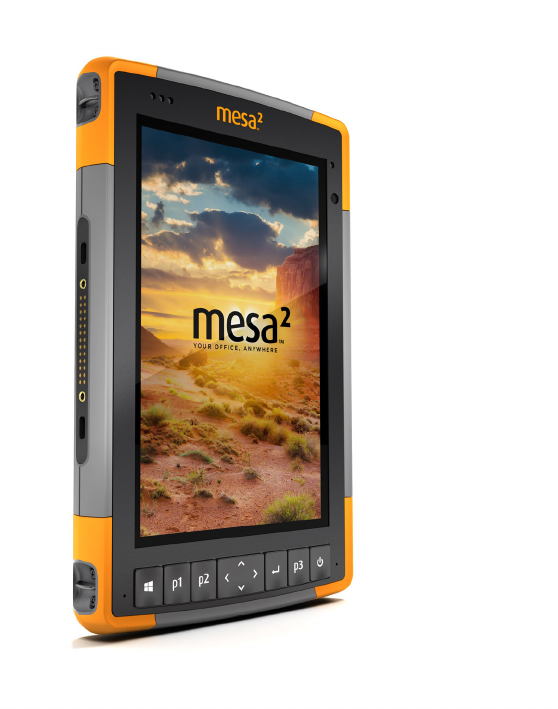
D
Specications
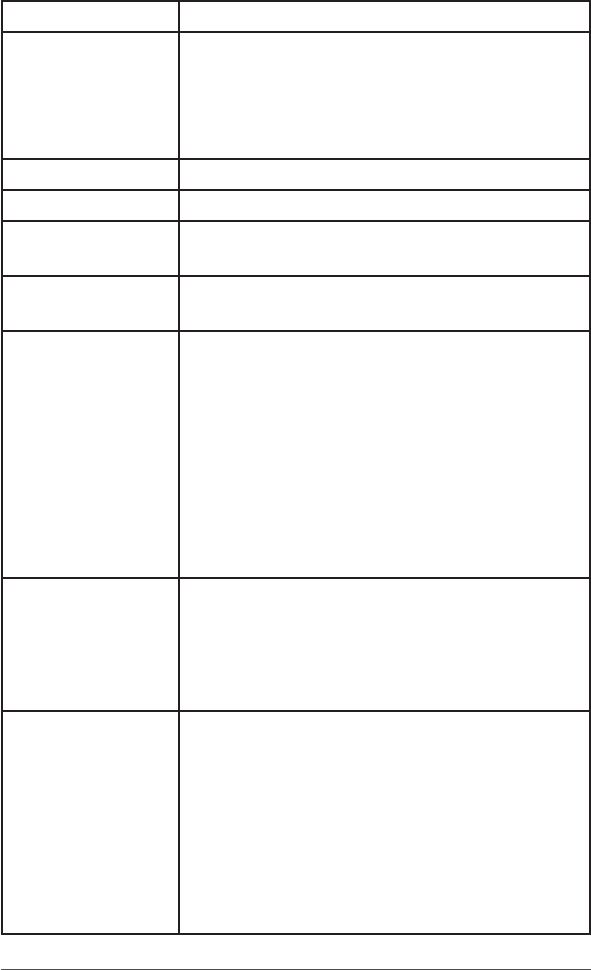
50 Mesa 2 Rugged Tablet Owner’s Manual
Mesa 2 Rugged Tablet Specications
Note: Specications are subject to change without notice.
FEATURE SPECIFICATION
Operating
System
Microsoft® Windows 10 Pro
English, French, German, Spanish,
Brazilian Portuguese are built in;
other languages are available for
download
Processor Quad-core Intel® Atom™ Z3745
Memory 4 GB RAM (LPDDR3)
Primary Data
Storage
64 or 128 GB ash storage
Micro SD/SDXC
Card Slot
SD/SDXC slot, user accessible
Physical
Features
Dimensions, standard: 5,4” wide x
8.48” long x 1.36” thick (137 mm x 215
mm x 35 mm)
Weight: 1.5 to 2.2 lb (680-907 g)
depending on battery conguration
and internal options installed
Durable, chemical- and shock-
resistant design
Easy-to-grip, impact-absorbing,
overmolded bumpers
Display Active viewing area: 7” (178 mm)
WXGA 800 x 1280 pixel resolution
Backlit LCD
Outdoor viewable
Portrait or landscape orientation
Touchscreen Capacitive multi-touch interface for
use with gloves, small tip stylus, and in
wet conditions
Chemically-strengthened
Dragontrail™ High Ion-Exchange
(HIE™) coverglass for impact and
scratch resistance
Touchscreen disable function
Touchscreen prole options
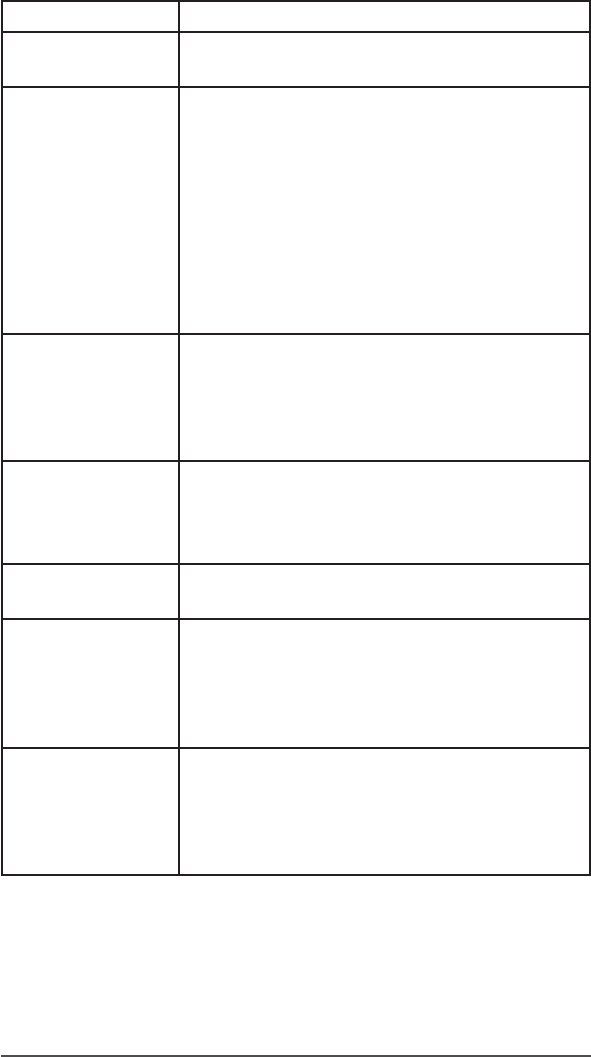
Appendix D Specications 51
FEATURE SPECIFICATION
Keyboard Programmable keys
Backlit keys
Batteries Rechargeable Li-Ion battery pack,
3.65 VDC 10600 mAh, 38.7 Whr
Run time of up to 20 hours
Charging time 4 to 6 hours
Built-in battery intelligence
User-replaceable
Optional internal 19.3 Whr battery
provides an additional 50% of runtime
and hot-swap capability; not user
replaceable (not user accessible)
Connector Ports USB 3.0 Host (full size A connector)
Power input is 10 V - 18 V, nominal 12
VDC
3.5 mm audio jack, supports stereo
headset/microphone
Wireless
Connectivity
Bluetooth® wireless technology 4.0,
extra long range
Wi-Fi 802.11 a/b/g/n 2.4 GHz and 5
GHz
Audio Mono speaker, loud and clear
Microphone, low noise
LED Activity
Indicators
Red: power applied/charging status
Green: application programmable
Blue: application programmable
Amber Light: Front or rear facing
camera is in use
Standard
Sensors/
Features
Ambient light sensor
Compass
Accelerometer
Gyroscope
TPM (Trusted Platform Module) v2.0
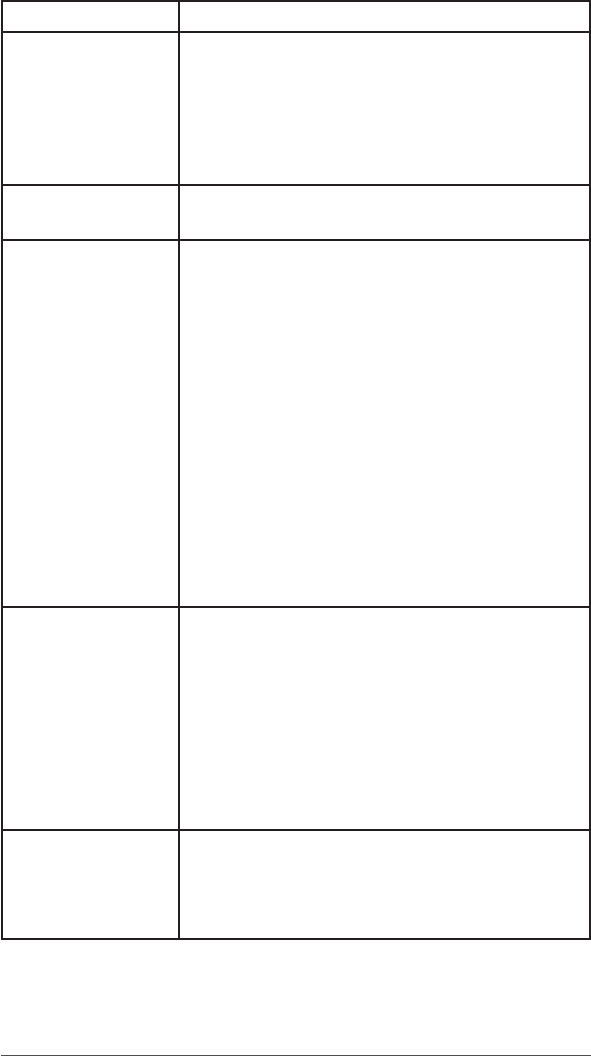
52 Mesa 2 Rugged Tablet Owner’s Manual
FEATURE SPECIFICATION
Temperature
Specications
Operating Temperature: –4° to 122° F
(–20° to 50° C).
Storage Temperature: –22° to 158° F
(–30° to 70° C)
Battery Charging Temperature: -4° to
140° F (-20° to 60° C)
Shock
Resistance
Withstands multiple 4 foot drops to
concrete
Environmental
Ratings and
Standards
IP68 rating (1.4 meters for 2 hours),
waterproof and dustproof
Designed to MIL-STD810G.
Tests:
ME-60: sand & dust
ME-51,53,& 54: X,Y,& Z-axis helicopter
vibe
ME-55, 56, & 57: X, Y, & Z -axis general
vibe
ME-52: Water Immersion, 1 meter
ME-59: Aggravated Temperature-
Humidity cycle
ME-67: Temperature cycle
ME-62: Temperature shock
ME-66: altitude
Certications
and Standards
FCC Class B
CE Marking (applicable EMC, R&TTE,
and LVD directives)
Industry Canada
EN60950 Safety
Bluetooth SIG qualication
IP68 waterproof and dustproof
Designed to MIL-STD 810G
RoHS 2 compliant
Warranties 24 months for Mesa 2
90 days for accessories
Extended service and maintenance
plans

Appendix D Specications 53
FEATURE SPECIFICATION
Software
Included
Alarms
Calculator
Calendar
Contacts
E-Mail
File Explorer
Help
Internet Explorer
Internet Sharing
Notes
Pictures & Videos
Remote Desktop
Search
Settings
Task Manager
Tasks
Software on individual units may vary
from this list.
Software on individual units may vary
from list based on the model
Congurations Standard with Wi-Fi, Bluetooth, 4 GB
RAM, 64 or 128 GB ash storage
Geo with Standard features plus
Front and Rear Cameras and a GNSS
Receiver and Antenna
Geo Barcode with Geo features plus
Integrated 1D/2D Barcode Scanner
Geo/Cell with Geo features plus
Integrated 4G LTE Modem
Geo /Cell Barcode with Geo Barcode
features plus Cell
US/North America and CE/EU models
Camera (Geo
models)
Resolution: 8 MP rear, 2 MP front
Autofocus
Video capture
JPEG image format
Flash

54 Mesa 2 Rugged Tablet Owner’s Manual
FEATURE SPECIFICATION
4G LTE Data
Modem (Geo
model option)
Sierra Wireless AirPrime EM7355 or
EM7305 (region dependant)
Supports micro-SIM card only. Micro-
SIM card header inside battery
compartment with card detect
feature and card retainer.
Does not support voice calls or SMS
Supports 3G UMTS, HSUPA, HSDPA,
HSPA, HSPA+, WCDMA, EVDO, LTE
* See more details at the end of this
chapter
GPS/GNSS (Geo
models)
2 to 5 meter typical accuracy
uBlox NEO-M8N GNSS receiver and
integrated antenna
Integrated real-time SBAS receiver
(WAAS, EGNOS, etc.)
72 GNSS tracking channels
Optional: uBlox NEO-M8T with post-
processing data output and external
GNSS antenna connection for sub-
meter accuracy
UHF RFID (RFID
Models)
Optional built-in UHF RFID module
and antenna
Region-specic frequency
congurations (859–873 MHz & 915–
930 MHz)
EPCglobal Gen 2 (ISO 18000-6C)
protocol support
Wide output range (0 dBm to +27
dBm)

Appendix D Specications 55
FEATURE SPECIFICATION
Barcode
1D/2D Imager
(Barcode
models)
Imager and Decoder: Motorola/
Symbol SE4710 imager and PL3307C
400 MHz decoder
Sensor Resolution: 1280 x 800
Field of View: Horizontal 42°, vertical
28°
Reading Angles: Skew & pitch ±60°,
roll 360°
Read Range: 1” to 24” depending on
code type, size, and density
Aiming dot: Visible with low light
illumination
Symbologies: All common 1D, 2D
(PDF417, MicroPDF417, Composite, RSS,
TLC-39, Data matrix, QR code, Micro
QR code, Aztec, MaxiCode, Postal
codes, etc.)
Trigger Buttons: Programmable
Barcode Connector™ Utility: Wedge
and conguration
Power: 1.49 W active, 0.54 W standby,
8 mW sleep; by default device returns
to sleep after 1 second of inactivity
Standard
Accessories
Removable Li-Ion battery
Adjustable hand strap
AC wall charger with international
plug kit
- Input: 10 0 -24 0 VAC, 50/60 Hz, 0.5 A
- Output: 12 VDC, 1.67 A
Capacitive ne tip stylus with tether
Quick Start Guide
Owner’s Manual (on our website)
Two year warranty on Mesa 2

56 Mesa 2 Rugged Tablet Owner’s Manual
FEATURE SPECIFICATION
Optional
Accessories
Internal extended battery, 3.65 V
@5300 mAh, 19.3 Whr Li-Ion
Integrated UHF RFID Reader and
Antenna
Integrated RS-232 9-Pin, D-Sub
Communication
uBlox NEO-M8T GNSS receiver and
external antenna connection
Survey/GPS pole clamp and mount
Vehicle charger cable, 12 V vehicle
power port, 6 ft.
Vehicle mounting dock with power
and communications.
Vehicle Dock/Pole mount - dock
attachment
Desktop dock, includes power/
charge input, HDMI output, 2 USB 2.0
(full size A), Ethernet
Travel charger
Shoulder strap
Serial cable
Holster carrying case
Flip cover tted case
4-point harness
SD cards in various sizes
Screen protector (anti-glare, ultra-
clear, or polarized)
Ofce 365
* 4G LTE Data Modem - Additional Information
Mode Model/Region Frequency Bands
LTE North America B2, B4, B5, B13, B17, B25
EU/ROW B1, B3, B7, B8, B20
UMTS/HSPA+ North America B1, B2, B4, B5, B8
EU/ROW B1, B2, B5, B8
GSM/GPRS/EDGE North America GSM 850, EGSM 900,
DCS 1800, PCS 1900
EU/ROW GSM 850, EGSM 900,
DCS 1800, PCS 1900
CDMA 1xRTT/ North America BC0, BC1, BC10
EV-DO Rev A
Note: ROW = Rest of World, or Non-North America
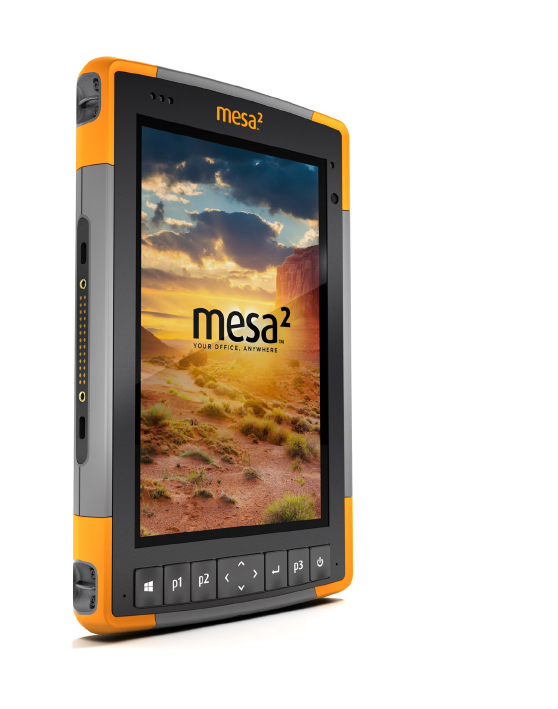
Index

58 Mesa 2 Rugged Tablet Owner’s Manual
Index
Symbols
4G Data Modem
Data Account, Set up With Wireless Provider 25
Maintenance of Your Modem 27
RF Interference Issues 27
Set up the Cell Modem 27
SIM Card Installation 25
A
Accessories
Optional 56
Standard 55
Action Center 10
AC Wall Charger 5, 14, 43
Anatomy of the Mesa 2 2–3
Audio Features 18
Audio Jack 18
Microphone 18
Speaker 18
B
Barcode Scanner 28
Sample Barcodes 28–29
Battery Compartment 3
Battery Door 2–3
Battery Pack, Internal 14 –15
Battery Pack, Removable 3–5, 14 –16
Battery Packs
Battery Life 14, 15
Charge 5, 14, 43
Install 4–5
Internal 2, 14 –15
Removable 3, 4, 13 –15
Specications 51
Status 14
Storage 32
Warnings 42
Bluetooth Wireless Communication 21–22

Index 59
C
Camera 25
Audio 25
Specications 53
Care and Maintenance
Cleaning 33
Storage 32
Cautions 17, 26, 33, 40
Certications and Standards 44
Canada 45
CE Marking, European Union 46
Licensing Information 47
Radio Frequency Safety 46
United States 44
Cleaning 33
Compass 21
Congurations 53
Connector Ports 3, 18
Ctrl-Alt-Delete Function 20
Task Manager 20
D
Data Modem 25
Set up a Data Account 25
Install the SIM Card 26
Data Storage 50
Declaration of Conformity 47
Display
Backlight 11
Magnier 11
Documentation 3
E
Environmental Ratings and Standards 52
Equipment Warnings 43
Excell Battery Company Charge Instructions 43

60 Mesa 2 Rugged Tablet Owner’s Manual
F
Features
Optional 24
Standard 10
G
Geo Model 24, 25
GPS/GNSS 24, 54
H
Hand Strap 7
Hibernate 19
K
Keypad
Backlight Brightness 13
Key Functions 12–13
Programmable Keys 13
L
Language Installs 8
LED Activity Indicators 16
Light Sensor 16
Limitation of Liability 38
Locked Up 20
M
Magnier 11
Memory 50
Microphone 18, 51
O
Operating System 10, 50
Install Languages 8
Updates 8
P
Physical Features 50
Powering Off and On 19

Index 61
Power Management
Battery Pack 14
Charging Battery Packs 16
Power Off 19
Product Warnings 42
R
Recovery Image 21
Recycling the Mesa 2 and Batteries 33
Removable Battery Pack 3–5
Repairing 40
System Information 40
Repairs, Upgrades, and Evaluations 40
Reset 20
Restore 21
RFID Reader 30
RS-232C Port 51
S
Screen Protector 56
SD Cards 17
Sensors 21
Accelerometer 21
Compass 21
Gyroscope 21
Service Plans 39
Set Up 6
Set up Tasks, Initial 3
SIM Card 3, 4, 26
Sleep 19
Software Included 53
Speaker 2
Specications 50–57
Start Menu 10
Storing the Mesa 2 32
Stylus 3, 7, 18
Stylus Storage Slot 2
Tether 7
System Information 10, 40

62 Mesa 2 Rugged Tablet Owner’s Manual
T
Tablet Mode 6
Task Manager 20
Temperature Specications 52
Touchscreen 10–12
Calibration Tool 12
Protecting the Touchscreen 33
Settings 10
Specications 50
U
Updates, Operating System and Documentation 8
USB Host 18
W
Wall Charger 5, 14, 43
Warnings 42–43
Battery Warnings 42–43
Wall Charger Warnings 43
Warranty 36–39
Exclusions 36
Limitation of Liability 38
Remedy 37
Repairs 38
Services 39
Warranty Exclusions 36
Wi-Fi Wireless Communication 22
Connecting to a Wi-Fi Network 22
Windows Start Menu 10
Wireless Safety 27
